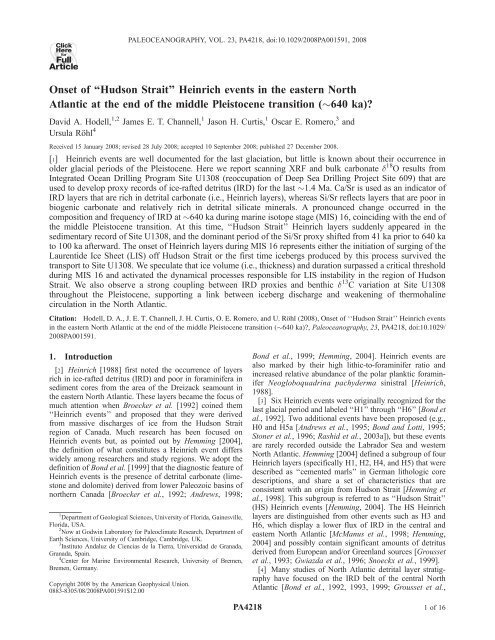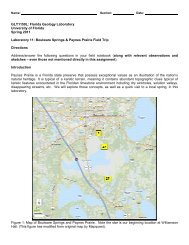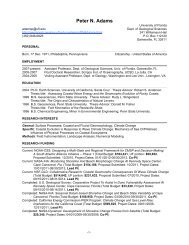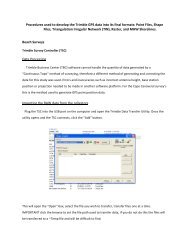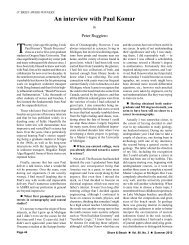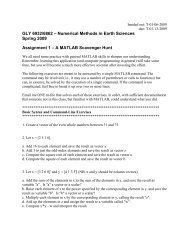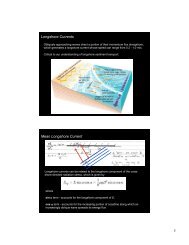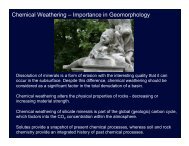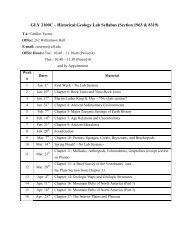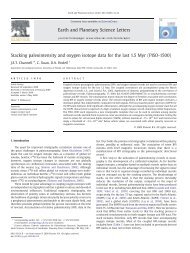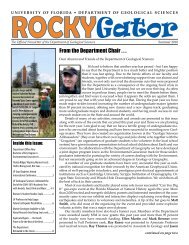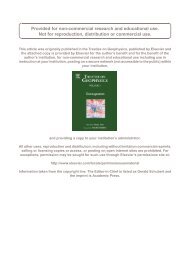Hodell et al 2008.pdf - Department of Geological Sciences
Hodell et al 2008.pdf - Department of Geological Sciences
Hodell et al 2008.pdf - Department of Geological Sciences
You also want an ePaper? Increase the reach of your titles
YUMPU automatically turns print PDFs into web optimized ePapers that Google loves.
Click<br />
Here<br />
for<br />
Full<br />
Article<br />
PALEOCEANOGRAPHY, VOL. 23, PA4218, doi:10.1029/2008PA001591, 2008<br />
Ons<strong>et</strong> <strong>of</strong> ‘‘Hudson Strait’’ Heinrich events in the eastern North<br />
Atlantic at the end <strong>of</strong> the middle Pleistocene transition (640 ka)<br />
David A. <strong>Hodell</strong>, 1,2 James E. T. Channell, 1 Jason H. Curtis, 1 Oscar E. Romero, 3 and<br />
Ursula Röhl 4<br />
Received 15 January 2008; revised 28 July 2008; accepted 10 September 2008; published 27 December 2008.<br />
[1] Heinrich events are well documented for the last glaciation, but little is known about their occurrence in<br />
older glaci<strong>al</strong> periods <strong>of</strong> the Pleistocene. Here we report scanning XRF and bulk carbonate d 18 O results from<br />
Integrated Ocean Drilling Program Site U1308 (reoccupation <strong>of</strong> Deep Sea Drilling Project Site 609) that are<br />
used to develop proxy records <strong>of</strong> ice-rafted d<strong>et</strong>ritus (IRD) for the last 1.4 Ma. Ca/Sr is used as an indicator <strong>of</strong><br />
IRD layers that are rich in d<strong>et</strong>rit<strong>al</strong> carbonate (i.e., Heinrich layers), whereas Si/Sr reflects layers that are poor in<br />
biogenic carbonate and relatively rich in d<strong>et</strong>rit<strong>al</strong> silicate miner<strong>al</strong>s. A pronounced change occurred in the<br />
composition and frequency <strong>of</strong> IRD at 640 ka during marine isotope stage (MIS) 16, coinciding with the end <strong>of</strong><br />
the middle Pleistocene transition. At this time, ‘‘Hudson Strait’’ Heinrich layers suddenly appeared in the<br />
sedimentary record <strong>of</strong> Site U1308, and the dominant period <strong>of</strong> the Si/Sr proxy shifted from 41 ka prior to 640 ka<br />
to 100 ka afterward. The ons<strong>et</strong> <strong>of</strong> Heinrich layers during MIS 16 represents either the initiation <strong>of</strong> surging <strong>of</strong> the<br />
Laurentide Ice She<strong>et</strong> (LIS) <strong>of</strong>f Hudson Strait or the first time icebergs produced by this process survived the<br />
transport to Site U1308. We speculate that ice volume (i.e., thickness) and duration surpassed a critic<strong>al</strong> threshold<br />
during MIS 16 and activated the dynamic<strong>al</strong> processes responsible for LIS instability in the region <strong>of</strong> Hudson<br />
Strait. We <strong>al</strong>so observe a strong coupling b<strong>et</strong>ween IRD proxies and benthic d 13 C variation at Site U1308<br />
throughout the Pleistocene, supporting a link b<strong>et</strong>ween iceberg discharge and weakening <strong>of</strong> thermoh<strong>al</strong>ine<br />
circulation in the North Atlantic.<br />
Citation: <strong>Hodell</strong>, D. A., J. E. T. Channell, J. H. Curtis, O. E. Romero, and U. Röhl (2008), Ons<strong>et</strong> <strong>of</strong> ‘‘Hudson Strait’’ Heinrich events<br />
in the eastern North Atlantic at the end <strong>of</strong> the middle Pleistocene transition (640 ka), P<strong>al</strong>eoceanography, 23, PA4218, doi:10.1029/<br />
2008PA001591.<br />
1. Introduction<br />
[2] Heinrich [1988] first noted the occurrence <strong>of</strong> layers<br />
rich in ice-rafted d<strong>et</strong>ritus (IRD) and poor in foraminifera in<br />
sediment cores from the area <strong>of</strong> the Dreizack seamount in<br />
the eastern North Atlantic. These layers became the focus <strong>of</strong><br />
much attention when Broecker <strong>et</strong> <strong>al</strong>. [1992] coined them<br />
‘‘Heinrich events’’ and proposed that they were derived<br />
from massive discharges <strong>of</strong> ice from the Hudson Strait<br />
region <strong>of</strong> Canada. Much research has been focused on<br />
Heinrich events but, as pointed out by Hemming [2004],<br />
the definition <strong>of</strong> what constitutes a Heinrich event differs<br />
widely among researchers and study regions. We adopt the<br />
definition <strong>of</strong> Bond <strong>et</strong> <strong>al</strong>. [1999] that the diagnostic feature <strong>of</strong><br />
Heinrich events is the presence <strong>of</strong> d<strong>et</strong>rit<strong>al</strong> carbonate (limestone<br />
and dolomite) derived from lower P<strong>al</strong>eozoic basins <strong>of</strong><br />
northern Canada [Broecker <strong>et</strong> <strong>al</strong>., 1992; Andrews, 1998;<br />
1 <strong>Department</strong> <strong>of</strong> Geologic<strong>al</strong> <strong>Sciences</strong>, University <strong>of</strong> Florida, Gainesville,<br />
Florida, USA.<br />
2 Now at Godwin Laboratory for P<strong>al</strong>eoclimate Research, <strong>Department</strong> <strong>of</strong><br />
Earth <strong>Sciences</strong>, University <strong>of</strong> Cambridge, Cambridge, UK.<br />
3 Instituto And<strong>al</strong>uz de Ciencias de la Tierra, Universidad de Granada,<br />
Granada, Spain.<br />
4 Center for Marine Environment<strong>al</strong> Research, University <strong>of</strong> Bremen,<br />
Bremen, Germany.<br />
Copyright 2008 by the American Geophysic<strong>al</strong> Union.<br />
0883-8305/08/2008PA001591$12.00<br />
Bond <strong>et</strong> <strong>al</strong>., 1999; Hemming, 2004]. Heinrich events are<br />
<strong>al</strong>so marked by their high lithic-to-foraminifer ratio and<br />
increased relative abundance <strong>of</strong> the polar planktic foraminifer<br />
Neogloboquadrina pachyderma sinistr<strong>al</strong> [Heinrich,<br />
1988].<br />
[3] Six Heinrich events were origin<strong>al</strong>ly recognized for the<br />
last glaci<strong>al</strong> period and labeled ‘‘H1’’ through ‘‘H6’’ [Bond <strong>et</strong><br />
<strong>al</strong>., 1992]. Two addition<strong>al</strong> events have been proposed (e.g.,<br />
H0 and H5a [Andrews <strong>et</strong> <strong>al</strong>., 1995; Bond and Lotti, 1995;<br />
Stoner <strong>et</strong> <strong>al</strong>., 1996; Rashid <strong>et</strong> <strong>al</strong>., 2003a]), but these events<br />
are rarely recorded outside the Labrador Sea and western<br />
North Atlantic. Hemming [2004] defined a subgroup <strong>of</strong> four<br />
Heinrich layers (specific<strong>al</strong>ly H1, H2, H4, and H5) that were<br />
described as ‘‘cemented marls’’ in German lithologic core<br />
descriptions, and share a s<strong>et</strong> <strong>of</strong> characteristics that are<br />
consistent with an origin from Hudson Strait [Hemming <strong>et</strong><br />
<strong>al</strong>., 1998]. This subgroup is referred to as ‘‘Hudson Strait’’<br />
(HS) Heinrich events [Hemming, 2004]. The HS Heinrich<br />
layers are distinguished from other events such as H3 and<br />
H6, which display a lower flux <strong>of</strong> IRD in the centr<strong>al</strong> and<br />
eastern North Atlantic [McManus <strong>et</strong> <strong>al</strong>., 1998; Hemming,<br />
2004] and possibly contain significant amounts <strong>of</strong> d<strong>et</strong>ritus<br />
derived from European and/or Greenland sources [Grouss<strong>et</strong><br />
<strong>et</strong> <strong>al</strong>., 1993; Gwiazda <strong>et</strong> <strong>al</strong>., 1996; Snoeckx <strong>et</strong> <strong>al</strong>., 1999].<br />
[4] Many studies <strong>of</strong> North Atlantic d<strong>et</strong>rit<strong>al</strong> layer stratigraphy<br />
have focused on the IRD belt <strong>of</strong> the centr<strong>al</strong> North<br />
Atlantic [Bond <strong>et</strong> <strong>al</strong>., 1992, 1993, 1999; Grouss<strong>et</strong> <strong>et</strong> <strong>al</strong>.,<br />
PA4218<br />
1<strong>of</strong>16
PA4218<br />
HODELL ET AL.: PLEISTOCENE HEINRICH EVENTS<br />
PA4218<br />
1993; Bond and Lotti, 1995; Snoeckx <strong>et</strong> <strong>al</strong>., 1999], whereas<br />
others have documented d<strong>et</strong>rit<strong>al</strong> events in more ice proxim<strong>al</strong><br />
locations such as the Labrador Sea [e.g., Andrews and<br />
Tedesco, 1992; Hillaire-Marcel <strong>et</strong> <strong>al</strong>., 1994; Stoner <strong>et</strong> <strong>al</strong>.,<br />
1995, 1996, 2000; Hiscott <strong>et</strong> <strong>al</strong>., 2001; Rashid <strong>et</strong> <strong>al</strong>., 2003a,<br />
2003b], the Irminger Basin <strong>of</strong>f east Greenland [Elliot <strong>et</strong> <strong>al</strong>.,<br />
1998; van Kreveld <strong>et</strong> <strong>al</strong>., 1996], and the Porcupine Seabight<br />
<strong>of</strong>f SW Ireland [Scourse <strong>et</strong> <strong>al</strong>., 2000; W<strong>al</strong>den <strong>et</strong> <strong>al</strong>., 2006;<br />
Peck <strong>et</strong> <strong>al</strong>., 2007]. Although Heinrich events have been well<br />
studied for the last glaci<strong>al</strong> cycle, less is known about their<br />
occurrence in older glaci<strong>al</strong> periods <strong>of</strong> the Pleistocene<br />
[Hiscott <strong>et</strong> <strong>al</strong>., 2001; Hemming, 2004]. Such studies have<br />
been hampered by the availability <strong>of</strong> long continuous cores<br />
with high sedimentation rates from the North Atlantic IRD<br />
belt.<br />
[5] Here we address sever<strong>al</strong> questions concerning the<br />
Pleistocene history <strong>of</strong> HS Heinrich events using proxy data<br />
from Integrated Ocean Drilling Program (IODP) Site U1308<br />
(reoccupation <strong>of</strong> Deep Sea Drilling Project (DSDP) Site 609):<br />
When did Heinrich layers first appear in the sedimentary<br />
record <strong>of</strong> the centr<strong>al</strong> North Atlantic Were they restricted to<br />
the ‘‘100-ka world’’ when continent<strong>al</strong> ice volume was large<br />
or are they <strong>al</strong>so found in the ‘‘41-ka world’’ when ice she<strong>et</strong>s<br />
were reduced in size What is the relationship b<strong>et</strong>ween<br />
Heinrich events and the Mid Pleistocene Transition (MPT)<br />
Is there a critic<strong>al</strong> ice volume (thickness) threshold or<br />
duration <strong>of</strong> glaci<strong>al</strong> conditions needed to produce Heinrich<br />
events What was the relationship b<strong>et</strong>ween Heinrich and<br />
other IRD events and thermoh<strong>al</strong>ine circulation during the<br />
Pleistocene<br />
2. Materi<strong>al</strong>s and M<strong>et</strong>hods<br />
2.1. IODP Site U1308<br />
[6] DSDP Site 609 has featured prominently in studies <strong>of</strong><br />
millenni<strong>al</strong>-sc<strong>al</strong>e climate variability <strong>of</strong> the last glaci<strong>al</strong> cycle,<br />
including the recognition <strong>of</strong> Heinrich events and their<br />
correlation to Greenland Ice cores [Bond <strong>et</strong> <strong>al</strong>., 1992,<br />
1993, 1999; McManus <strong>et</strong> <strong>al</strong>., 1994; Bond and Lotti,<br />
1995]. DSDP Site 609 is located near the center <strong>of</strong> the<br />
North Atlantic IRD belt that trends west-southwest <strong>al</strong>ong<br />
latitude 46 to 50°N and marks the band <strong>of</strong> maximum<br />
iceberg melting and IRD deposition during the last glaciation<br />
(Figure 1 [Ruddiman, 1977]). During IODP Exp 303,<br />
DSDP Site 609 was reoccupied and a compl<strong>et</strong>e composite<br />
section was obtained at Site U1308 to 239 m composite<br />
depth (mcd) [Expedition 303 Scientists, 2006]. The apparent<br />
continuity <strong>of</strong> the recovered section at Site U1308 represents<br />
a significant improvement on the section recovered 25 years<br />
ago at DSDP Site 609 that preceded the shipboard construction<br />
<strong>of</strong> composite sections. The water depth <strong>of</strong> 3427 m<br />
places the site within lower North Atlantic Deep Water<br />
(NADW) in the open Atlantic out <strong>of</strong> the direct path <strong>of</strong><br />
overflows from the Norwegian-Greenland Sea.<br />
[7] Here we report data from the upper 100 mcd at Site<br />
U1308. In this interv<strong>al</strong>, the shipboard composite section was<br />
modified postcruise because a few core sections used in the<br />
shipboard splice showed evidence <strong>of</strong> disturbance during<br />
postcruise sampling (Table 1).<br />
2.2. Stable Isotopes<br />
[8] Stable isotopes were measured on the benthic foraminifer<br />
Cibicidoides wuellerstorfi and/or Cibicidoides<br />
kullenbergi at a sample spacing <strong>of</strong> 2 cm for the upper<br />
100 mcd <strong>of</strong> Site U1308. Specimens were picked from the<br />
>212-mm size fraction, and one to five individu<strong>al</strong>s were<br />
used for an<strong>al</strong>ysis. Foraminifer tests were soaked in 15%<br />
H 2 O 2 for 30 min to remove organic matter. The tests were<br />
then rinsed with m<strong>et</strong>hanol and sonic<strong>al</strong>ly cleaned to remove<br />
fine-grained particles. The m<strong>et</strong>hanol was removed with a<br />
syringe, and samples were dried in an oven at 50°C for 24 h.<br />
The foraminifer tests were crushed and b<strong>et</strong>ween 20 to 60 mg<br />
<strong>of</strong> c<strong>al</strong>cite was loaded into glass reaction vessels, and reacted<br />
with three drops <strong>of</strong> H 3 PO 4 (specific gravity = 1.92) using a<br />
Finnigan MAT Kiel III carbonate preparation device. Isotope<br />
ratios were measured online by a Finnigan MAT 252<br />
mass spectrom<strong>et</strong>er. An<strong>al</strong>ytic<strong>al</strong> precision was estimated to<br />
be ±0.07 for d 18 O and ±0.03 for d 13 C by measuring eight<br />
standards (NBS-19) with each s<strong>et</strong> <strong>of</strong> 38 samples.<br />
2.3. Magn<strong>et</strong>ic Susceptibility<br />
[9] Whole cores were logged aboard the JOIDES Resolution<br />
using a GEOTEK multisensor core logger. Shipboard<br />
logging was carried out at 5-cm resolution. Sediment bulk<br />
density was estimated by gamma ray attenuation (GRA) and<br />
magn<strong>et</strong>ic susceptibility was measured using the 4.5-cm<br />
Bartington loop sensor. We <strong>al</strong>so took u-channel samples<br />
(plastic containers with a 2 2 cm square cross section and<br />
a typic<strong>al</strong> length <strong>of</strong> 150 cm [Tauxe <strong>et</strong> <strong>al</strong>., 1983]) from the<br />
center <strong>of</strong> split core sections <strong>al</strong>ong the spliced composite<br />
section and remeasured magn<strong>et</strong>ic susceptibility every 1 cm<br />
using a custom-built instrument in the P<strong>al</strong>eomagn<strong>et</strong>ic Laboratory<br />
at the University <strong>of</strong> Florida [Thomas <strong>et</strong> <strong>al</strong>., 2003;<br />
Channell <strong>et</strong> <strong>al</strong>., 2008]. The 3.3-cm square coil <strong>of</strong> this<br />
instrument has a sm<strong>al</strong>ler response function (3-cm h<strong>al</strong>f peak<br />
width) than the 4.5-cm Bartington loop sensor (10-cm h<strong>al</strong>f<br />
peak width) used aboard ship, thereby providing greater<br />
spati<strong>al</strong> resolution. The susceptibility m<strong>et</strong>er was zeroed<br />
before each section was an<strong>al</strong>yzed and a drift correction<br />
applied b<strong>et</strong>ween the beginning and end <strong>of</strong> each section<br />
an<strong>al</strong>yzed.<br />
2.4. XRF An<strong>al</strong>ysis<br />
[10] Using an Avaatech XRF core scanner at the University<br />
<strong>of</strong> Bremen, we measured the full suite <strong>of</strong> elements<br />
b<strong>et</strong>ween Al and Ba in the upper 100 mcd <strong>of</strong> the spliced<br />
composite section <strong>of</strong> Site U1308. The split core surface was<br />
carefully scraped cleaned and covered with a 4 mm thin<br />
SPEXCertiPrep Ultr<strong>al</strong>ene foil to avoid contamination and<br />
prevent desiccation [Richter <strong>et</strong> <strong>al</strong>., 2006]. Each section was<br />
scanned twice: once at 0.2 milliamps (mA) and 10 kilovolts<br />
(kV) to measure Al to Fe (including Si and Ca) and another<br />
at 1 mA and 50 kV to measure Rb through Ba (including<br />
Sr). A 1-cm 2 area <strong>of</strong> the core surface was irradiated with<br />
X rays using 30 s count time. XRF data were collected<br />
every 1 cm <strong>al</strong>ong the spliced section <strong>of</strong> Site U1308,<br />
resulting in 10,000 measurements with an average tempor<strong>al</strong><br />
resolution <strong>of</strong> less than 200 years. Element<strong>al</strong> ratios<br />
(Ca/Sr and Si/Sr) were c<strong>al</strong>culated using the corrected<br />
counts for each <strong>of</strong> the respective elements.<br />
2<strong>of</strong>16
PA4218<br />
HODELL ET AL.: PLEISTOCENE HEINRICH EVENTS<br />
PA4218<br />
Figure 1. Position <strong>of</strong> IODP Sites U1302/03, U1304, and U1308 relative to IRD accumulation for the<br />
last glaciation (modified after Ruddiman [1977]). Arrows represent mean paths <strong>of</strong> distributions <strong>of</strong> icerafted<br />
debris during glaci<strong>al</strong> periods inferred by Ruddiman [1977].<br />
Table 1. Modified Sampling Splice Tie Points, Site U1308<br />
Site Hole Core Type Section<br />
Interv<strong>al</strong><br />
(cm)<br />
Depth<br />
(mbsf)<br />
Depth<br />
(mcd)<br />
Corresponding Splice Tie Point<br />
Site Hole Core Type Section<br />
Interv<strong>al</strong><br />
(cm)<br />
Depth<br />
(mbsf)<br />
1308 C 1 H 2 144 2.94 2.94 1308 E 1 H 2 12 1.62 2.94<br />
1308 E 1 H 7 10 9.1 10.42 1308 C 2 H 3 6 7.46 10.42<br />
1308 C 2 H 5 106 11.46 14.42 1308 E 2 H 2 12 11.12 14.42<br />
1308 E 2 H 6 126 18.26 21.56 1308 C 3 H 2 138 16.78 21.56<br />
1308 C 3 H 6 40 21.8 26.58 1308 E 3 H 2 58 21.08 26.58<br />
1308 E 3 H 4 106 24.56 30.06 1308 B 4 H 3 16 26.16 30.06<br />
1308 B 4 H 6 28 30.78 34.68 1308 A 4 H 2 92 30.02 34.68<br />
1308 A 4 H 5 142 35.02 39.68 1308 C 5 H 1 142 34.32 39.68<br />
1308 C 5 H 5 72 39.62 44.98 1308 A 5 H 2 86 39.46 44.98<br />
1308 A 5 H 6 76 45.34 50.86 1308 C 6 H 1 104 43.44 50.86<br />
1308 C 6 H 5 144 49.81 57.23 1308 F 6 H 3 4 49.97 57.23<br />
1308 F 6 H 6 126 55.69 62.95 1308 B 7 H 3 34 54.84 62.95<br />
1308 B 7 H 6 68 59.68 67.79 1308 A 7 H 2 132 58.92 67.79<br />
1308 A 7 H 3 142 60.52 69.39 1308 F 7 H 2 124 59.74 69.39<br />
1308 F 7 H 5 136 64.36 74.01 1308 C 8 H 2 94 63.84 74.01<br />
1308 C 8 H 5 66 68.06 78.23 1308 A 8 H 3 104 69.64 78.23<br />
1308 A 8 H 6 74 73.84 82.41 1308 B 9 H 2 75.5 72.76 82.41<br />
1308 B 9 H 5 76.8 77.27 86.94 1308 E 9 H 2 6 80.56 86.94<br />
1308 E 9 H 5 28.5 85.29 91.63 1308 F 9 H 3 5.1 79.05 91.63<br />
1308 F 9 H 6 119.1 84.69 97.29 1308 A 10 H 2 107 87.17 97.29<br />
1308 A 10 H 6 98.7 93.09 103.21<br />
Depth<br />
(mcd)<br />
3<strong>of</strong>16
PA4218<br />
HODELL ET AL.: PLEISTOCENE HEINRICH EVENTS<br />
PA4218<br />
Figure 2. Benthic oxygen isotope record <strong>of</strong> Site U1308 (red) compared to the stacked oxygen isotope<br />
record <strong>of</strong> Lisiecki and Raymo [2005] (LR04; blue).<br />
[11] We verified the scanning XRF data from the splitcore<br />
sediment surface by an<strong>al</strong>yzing dried, homogenized<br />
powders <strong>of</strong> 50 samples from Sites U1308 using a convention<strong>al</strong><br />
XRF an<strong>al</strong>yzer (Spectro Xepos EDPXRF) [Wien <strong>et</strong> <strong>al</strong>.,<br />
2005]. This m<strong>et</strong>hod has been shown to be effective for<br />
c<strong>al</strong>ibrating scanning XRF data [Tj<strong>al</strong>lingii <strong>et</strong> <strong>al</strong>., 2007].<br />
Approximately 10 cc <strong>of</strong> sediment were sampled at 50 depths<br />
at Site U1308, freeze dried, ground, and 4 g <strong>of</strong> sediment<br />
was loosely packed into plastic sample holders with bottoms<br />
consisting <strong>of</strong> 4-mm XRF foil. The samples selected included<br />
a range <strong>of</strong> Ca, Si and Sr v<strong>al</strong>ues and ratios and included<br />
Heinrich events 1 through 6 (see auxiliary materi<strong>al</strong>). 1<br />
2.5. Bulk Carbonate d 18 O<br />
[12] For bulk stable isotope an<strong>al</strong>ysis, 1 cc <strong>of</strong> sediment<br />
was dried in an oven at 50°C and the sample was ground to<br />
a homogenous powder. Bulk samples were reacted in a VG<br />
Isocarb carbonate preparation device with H 3 PO 4 at 90°C<br />
for 15 min which is sufficient to react both c<strong>al</strong>cite and<br />
dolomite compl<strong>et</strong>ely. Oxygen and carbon isotopes <strong>of</strong><br />
evolved CO 2 gas were measured using a Micromass PRISM<br />
Series II mass spectrom<strong>et</strong>er. An<strong>al</strong>ytic<strong>al</strong> precision (1 standard<br />
deviation) was estimated to be ±0.06% for d 18 O and<br />
±0.04% for d 13 C by measuring standards (NBS-19, n =<br />
85) with each s<strong>et</strong> <strong>of</strong> 36 samples.<br />
2.6. Age Model<br />
[13] The age model <strong>of</strong> Site U1308 was constructed using<br />
radiocarbon dates and oxygen isotope stratigraphy (Figure 2<br />
and Table 2). Back to 35 ka, radiocarbon dates from DSDP<br />
Site 609 [Bond <strong>et</strong> <strong>al</strong>., 1993] were transferred to the mcd<br />
sc<strong>al</strong>e <strong>of</strong> Site U1308 by correlating gray sc<strong>al</strong>e sign<strong>al</strong>s<br />
obtained from core photographs (see auxiliary materi<strong>al</strong>).<br />
1 Auxiliary materi<strong>al</strong>s are available in the HTML. doi:10.1029/<br />
2008PA001591.<br />
From 35 to 60 ka, the benthic d 18 O record was correlated to<br />
MD95–2042 thereby utilizing the SFCP04 time sc<strong>al</strong>e<br />
[Shackl<strong>et</strong>on <strong>et</strong> <strong>al</strong>., 2004] that has <strong>al</strong>so been applied to the<br />
Greenland ice cores [Svensson <strong>et</strong> <strong>al</strong>., 2006]. Prior to 60 ka,<br />
the benthic d 18 O record was correlated to the stacked d 18 O<br />
record <strong>of</strong> Lisiecki and Raymo [2005]. Every isotopic stage<br />
b<strong>et</strong>ween marine isotope stage (MIS) 1 and 50 is identifiable,<br />
supporting the compl<strong>et</strong>eness <strong>of</strong> the composite section at Site<br />
U1308. Benthic foraminifera are scarce at the transition <strong>of</strong><br />
MIS 10 to MIS 9 and, consequently, the position <strong>of</strong><br />
Termination IV is not well constrained. Sedimentation rates<br />
average 7 cm/ka in the upper 100 mcd but interv<strong>al</strong><br />
sedimentation rates vary considerably.<br />
3. Results<br />
3.1. IRD Proxies<br />
[14] Core scanning XRF data from Site U1308 were<br />
compared with existing p<strong>et</strong>rologic counts <strong>of</strong> ice-rafted<br />
d<strong>et</strong>ritus (IRD) from DSDP Site 609 [Bond <strong>et</strong> <strong>al</strong>., 1992,<br />
1999; Bond and Lotti, 1995] to identify proxies for monitoring<br />
various components <strong>of</strong> IRD. Ca and Sr are highly<br />
correlated and covary over glaci<strong>al</strong>-to-interglaci<strong>al</strong> cycles <strong>of</strong><br />
the Pleistocene, reflecting variations in biogenic carbonate<br />
content <strong>of</strong> the sediment (Figure 3). An exception occurs<br />
during the Heinrich layers H1, H2, H4 and H5, however,<br />
when Ca increases but Sr remains relatively low (Figure 4).<br />
These HS Heinrich layers <strong>al</strong>so display high Ca/Sr when<br />
measured on dried, homogenized samples using a convention<strong>al</strong><br />
XRF instrument (see auxiliary materi<strong>al</strong>). The greatest<br />
Ca/Sr ratios in the core occur when d<strong>et</strong>rit<strong>al</strong> carbonate<br />
content is high and biogenic carbonate is low. This relationship<br />
occurs because biogenic c<strong>al</strong>cite precipitated by<br />
coccoliths and foraminifera has a greater Sr concentration<br />
than inorganic<strong>al</strong>ly precipitated c<strong>al</strong>cite or dolomite owing to<br />
the fact that the Sr partition coefficient (K DSr ) for biogenic<br />
4<strong>of</strong>16
PA4218<br />
HODELL ET AL.: PLEISTOCENE HEINRICH EVENTS<br />
PA4218<br />
Table 2. Depth-Age Points Used to Construct Chronology for Site<br />
U1308 a<br />
Depth (mcd) Age (ka) C<strong>al</strong>ibration<br />
0.68 13.8<br />
14 C<br />
0.69 13.0<br />
14 C<br />
0.74 13.0<br />
14 C<br />
0.80 14.4<br />
14 C<br />
0.82 15.6<br />
14 C<br />
0.87 15.4<br />
14 C<br />
0.92 17.4<br />
14 C<br />
0.95 19.1<br />
14 C<br />
0.99 19.5<br />
14 C<br />
1.08 20.1<br />
14 C<br />
1.18 22.5<br />
14 C<br />
1.23 23.7<br />
14 C<br />
1.25 25.3<br />
14 C<br />
1.29 25.6<br />
14 C<br />
1.34 26.9<br />
14 C<br />
1.59 30.4<br />
14 C<br />
1.63 31.7<br />
14 C<br />
1.69 31.4<br />
14 C<br />
1.76 34.6<br />
14 C<br />
1.90 35.3 SFCP04<br />
2.01 36.1 SFCP04<br />
2.80 40.1 SFCP04<br />
3.10 42.7 SFCP04<br />
3.50 48.0 SFCP04<br />
4.14 56.0 SFCP04<br />
4.50 62 LR04<br />
5.24 72 LR04<br />
5.90 86 LR04<br />
6.22 93 LR04<br />
7.06 104 LR04<br />
8.75 127 LR04<br />
9.17 136 LR04<br />
11.54 191 LR04<br />
12.42 201 LR04<br />
13.65 220 LR04<br />
15.32 243 LR04<br />
18.06 281 LR04<br />
18.74 292 LR04<br />
21.42 325 LR04<br />
21.85 341 LR04<br />
24.73 392 LR04<br />
27.40 431 LR04<br />
29.06 475 LR04<br />
32.68 513 LR04<br />
34.92 534 LR04<br />
37.56 580 LR04<br />
38.58 596 LR04<br />
39.88 622 LR04<br />
43.72 690 LR04<br />
47.24 726 LR04<br />
48.72 746 LR04<br />
51.14 788 LR04<br />
52.58 814 LR04<br />
56.41 866 LR04<br />
58.52 902 LR04<br />
60.20 922 LR04<br />
64.37 964 LR04<br />
65.71 978 LR04<br />
65.97 984 LR04<br />
67.73 998 LR04<br />
68.05 1004 LR04<br />
70.41 1032 LR04<br />
72.07 1058 LR04<br />
72.77 1070 LR04<br />
77.25 1098 LR04<br />
78.25 1108 LR04<br />
79.99 1126 LR04<br />
80.75 1132 LR04<br />
86.10 1200 LR04<br />
87.20 1218 LR04<br />
Table 2. (continued)<br />
Depth (mcd) Age (ka) C<strong>al</strong>ibration<br />
87.56 1222 LR04<br />
89.90 1250 LR04<br />
91.86 1290 LR04<br />
94.38 1316 LR04<br />
96.62 1340 LR04<br />
98.20 1354 LR04<br />
100.68 1372 LR04<br />
102.20 1398 LR04<br />
102.96 1406 LR04<br />
103.71 1412 LR04<br />
103.96 1418 LR04<br />
104.67 1426 LR04<br />
105.63 1442 LR04<br />
106.31 1448 LR04<br />
106.46 1456 LR04<br />
108.71 1488 LR04<br />
109.04 1496 LR04<br />
109.99 1510 LR04<br />
a Radiocarbon dates from Bond <strong>et</strong> <strong>al</strong>. [1993]. SFCP04, Shackl<strong>et</strong>on <strong>et</strong> <strong>al</strong>.<br />
[2004]; LR04, Lisiecki and Raymo [2005].<br />
c<strong>al</strong>cite is much greater than that for inorganic c<strong>al</strong>cite and<br />
dolomite.<br />
[15] At Site U1308, four distinct Ca/Sr peaks occurred<br />
during the last glaci<strong>al</strong> period corresponding to Heinrich<br />
layers 1, 2, 4, and 5 at Site 609 (Figures 5a and 5b). These<br />
four layers were origin<strong>al</strong>ly described as ‘‘cemented marls’’<br />
[see Hemming, 2004] and are <strong>al</strong>so marked by increases in<br />
density and magn<strong>et</strong>ic susceptibility (Figure 5c). Magn<strong>et</strong>ic<br />
susceptibility has been shown previously to serve as a proxy<br />
for IRD deposition in North Atlantic sediments [Robinson <strong>et</strong><br />
<strong>al</strong>., 1995; Stoner <strong>et</strong> <strong>al</strong>., 1996; Stoner and Andrews, 1999;<br />
Kissel, 2005]. H3 and H6 are not associated with peaks in<br />
Ca/Sr and are marked by low carbonate content at Site<br />
U1308. The low carbonate <strong>of</strong> H3 and H6 may be a result <strong>of</strong><br />
dissolution and/or low carbonate productivity [Gwiazda <strong>et</strong><br />
<strong>al</strong>., 1996]. Although Bond <strong>et</strong> <strong>al</strong>. [1992] reported sm<strong>al</strong>l<br />
increases in percent d<strong>et</strong>rit<strong>al</strong> carbonate associated with H3<br />
and H6 at Site 609 (Figure 5a), the amount is too sm<strong>al</strong>l to be<br />
d<strong>et</strong>ected by Ca/Sr measured by scanning or convention<strong>al</strong><br />
XRF. Ji <strong>et</strong> <strong>al</strong>. [2008] found dolomite to be present in H3 and<br />
H6 at Site U1308, but concentrations were barely above<br />
background levels as measured by XRD and only 3%<br />
dolomite estimated by FTIR. In contrast, H1, H2, H4 and<br />
H5 have >15% dolomite [Ji <strong>et</strong> <strong>al</strong>., 2008]. In cores from the<br />
Labrador Sea, however, H3 and H6 are associated with<br />
increases in d<strong>et</strong>rit<strong>al</strong> carbonate believed to be sourced from<br />
Hudson Strait [Hillaire-Marcel <strong>et</strong> <strong>al</strong>., 1994; Stoner <strong>et</strong> <strong>al</strong>.,<br />
1998; Rashid <strong>et</strong> <strong>al</strong>., 2003a, 2003b]. If H3 and H6 were <strong>al</strong>so<br />
caused by surging <strong>of</strong> Hudson Strait ice, then most ice bergs<br />
may have melted in the western Atlantic with low fluxes to<br />
the centr<strong>al</strong> and eastern parts <strong>of</strong> the IRD belt [Gwiazda <strong>et</strong> <strong>al</strong>.,<br />
1996].<br />
[16] Bulk carbonate d 18 O at Site U1308 reflects the<br />
relative proportion <strong>of</strong> biogenic and d<strong>et</strong>rit<strong>al</strong> carbonate and<br />
resembles the lithic-to-foraminifer ratio at Site 609 (Figures<br />
5d and 5e [<strong>Hodell</strong> and Curtis, 2008]). All six Heinrich<br />
layers are marked by decreases in bulk carbonate d 18 O;<br />
however, the decrease is less for H3 and H6 than for other<br />
5<strong>of</strong>16
PA4218<br />
HODELL ET AL.: PLEISTOCENE HEINRICH EVENTS<br />
PA4218<br />
Figure 3. Ca versus Sr for the top 100 mcd at Site U1308. D<strong>et</strong>rit<strong>al</strong> carbonate events are marked by high<br />
Ca and low Sr as indicated by area enclosed by ov<strong>al</strong>.<br />
Figure 4. (a) Peak areas for Ca (blue) and Sr (red) measured by scanning XRF for the upper 6 mcd at<br />
Site U1308, (b) ratio <strong>of</strong> Ca to Sr, and (c) magn<strong>et</strong>ic susceptibility (green) and density (brown). Positions <strong>of</strong><br />
Heinrich events 1, 2, 4 and 5, are highlighted by orange shading.<br />
6<strong>of</strong>16
PA4218<br />
HODELL ET AL.: PLEISTOCENE HEINRICH EVENTS<br />
PA4218<br />
Figure 5. Comparison <strong>of</strong> (a) percent d<strong>et</strong>rit<strong>al</strong> carbonate (red) at Site 609 [Bond <strong>et</strong> <strong>al</strong>., 1992] with (b) Ca/Sr,<br />
(c) magn<strong>et</strong>ic susceptibility, (d) bulk carbonate d 18 O, (e) the ratio <strong>of</strong> lithics to foraminifera (green) at Site 609<br />
[Bond <strong>et</strong> <strong>al</strong>., 1992], and (f) Si/Sr at Site U1308.<br />
Heinrich events (Figure 5d). During HS Heinrich layers 1,<br />
2, 4 and 5, bulk d 18 O decreases to approximately 5% and<br />
v<strong>al</strong>ues are indistinguishable from those <strong>of</strong> d<strong>et</strong>rit<strong>al</strong> carbonate<br />
grains in the coarse fraction [<strong>Hodell</strong> and Curtis, 2008].<br />
During H3 and H6, d 18 O decreases to only about 2%. No<br />
change in bulk d 18 O is associated with H0 or H5a.<br />
[17] The ratio <strong>of</strong> Si to Sr (Si/Sr) at Site U1308 resembles<br />
the lithic-to-foraminifer ratio at Site 609 [Bond <strong>et</strong> <strong>al</strong>., 1992]<br />
(Figure 5f). We use Si/Sr and bulk carbonate d 18 O to<br />
recognize layers in cores from Site U1308 that are poor in<br />
biogenic carbonate (i.e., low Sr and Ca) and relatively rich<br />
in d<strong>et</strong>rit<strong>al</strong> silicate miner<strong>al</strong>s (e.g., quartz, feldspar, <strong>et</strong>c.).<br />
Peaks in Si/Sr tend to co-occur with lows in bulk carbonate<br />
d 18 O, and may represent either decreased biogenic carbonate<br />
productivity and/or increased delivery <strong>of</strong> IRD rich in<br />
silicate miner<strong>al</strong>s.<br />
3.2. Downcore Variations in IRD Proxies<br />
[18] The criteria used to recognize HS (‘‘cemented marl–<br />
type’’) Heinrich layers in the older record at Site U1308<br />
includes a concomitant increase in Ca/Sr, density and<br />
magn<strong>et</strong>ic susceptibility, and a decrease <strong>of</strong> bulk carbonate<br />
d 18 Oto< 5% as observed during H1, 2, 4 and 5 during the<br />
last glaciation (Figures 5 and 6a). IRD events that are poor<br />
in d<strong>et</strong>rit<strong>al</strong> carbonate and rich in silicate miner<strong>al</strong>s are<br />
identified by peaks in Si/Sr, low Ca/Sr, and decreases in<br />
bulk d 18 O reaching about 2% (Figures 5 and 6a). In<br />
contrast to the last glaciation, MIS 6 shows no evidence for<br />
any HS d<strong>et</strong>rit<strong>al</strong> carbonate layers, but two peaks in Si/Sr<br />
and lows in bulk d 18 O are observed (Figure 6b). An IRD<br />
event occurs at Termination II and coincides with H11<br />
described elsewhere in North Atlantic cores [Heinrich,<br />
1988; McManus <strong>et</strong> <strong>al</strong>., 1994; Chapman and Shackl<strong>et</strong>on,<br />
1998; Lototskaya and Ganssen, 1999; Oppo <strong>et</strong> <strong>al</strong>., 2001,<br />
2006], whereas the other occurs at 150 ka. MIS 8 contains<br />
three HS Heinrich layers including one at Termination<br />
III (Figure 6c). A Si-rich IRD event precedes the<br />
Heinrich layer at Termination III and another occurs at<br />
273 ka. A large peak in Ca/Sr occurs on Termination IV<br />
<strong>al</strong>though the exact position <strong>of</strong> the deglaciation is difficult to<br />
locate because <strong>of</strong> a gap in the benthic isotope record at the<br />
transition from MIS 10 to 9 (Figure 6d). MIS 12 contains<br />
one HS Heinrich layer centered on Termination V, and<br />
multiple peaks in Si/Sr and lows in bulk d 18 O occur<br />
throughout the glaciation (Figure 6e). No d<strong>et</strong>rit<strong>al</strong> carbonate<br />
layers occur in MIS 14 which was a relatively weak<br />
glaciation. Two HS Heinrich layers occurred during MIS<br />
16, including one associated with Termination VI<br />
(Figure 6f). In addition, there were many peaks in Si/Sr<br />
and lows in bulk d 18 O during MIS 16. No d<strong>et</strong>rit<strong>al</strong> carbonate<br />
layers occur in any <strong>of</strong> the glaci<strong>al</strong> periods older than MIS 16<br />
during the past 1.4 Ma (Figure 7).<br />
[19] A distinct change in the frequency and amplitude <strong>of</strong><br />
IRD proxies occurred at 640 ka in MIS 16. The frequency<br />
7<strong>of</strong>16
PA4218<br />
HODELL ET AL.: PLEISTOCENE HEINRICH EVENTS<br />
PA4218<br />
Figure 6<br />
8<strong>of</strong>16
PA4218<br />
HODELL ET AL.: PLEISTOCENE HEINRICH EVENTS<br />
PA4218<br />
Figure 6.<br />
<strong>of</strong> magn<strong>et</strong>ic susceptibility and density variations diminishes<br />
(Figures 7a and 7b) and the amplitude increases associated<br />
with the first occurrence <strong>of</strong> d<strong>et</strong>rit<strong>al</strong> carbonate layers (Figure<br />
7c). The amplitude <strong>of</strong> Si/Sr variations decrease and Si/Sr<br />
peaks become less frequent after MIS 16 (Figure 7d). Bulk<br />
carbonate d 18 O <strong>al</strong>so shows a change from more frequent<br />
lows with minimum v<strong>al</strong>ues <strong>of</strong> 2% prior to 640 ka, to less<br />
frequent lows after 640 ka with minimum v<strong>al</strong>ues reaching<br />
5% during HS Heinrich layers (Figure 7e).<br />
4. Discussion<br />
4.1. HS Heinrich Events in Older Glaci<strong>al</strong> Periods<br />
[20] We follow the lead <strong>of</strong> Hemming [2004] and distinguish<br />
‘‘cemented marl–type’’ Heinrich events that originate<br />
from Hudson Strait (HS) from other types <strong>of</strong> Heinrich and<br />
IRD events whose origins are more ambiguous. HS Heinrich<br />
events were not limited to the last glaciation at Site<br />
U1308 and the number <strong>of</strong> layers varied from 4 (MIS2–4), 3<br />
(MIS 8), 2 (MIS 16 and 10), to 1 (MIS 12) (Figures 6 and<br />
7). During each <strong>of</strong> the glaci<strong>al</strong> periods, HS Heinrich layers<br />
are found toward the latter part <strong>of</strong> the glaci<strong>al</strong> cycle and<br />
<strong>al</strong>most <strong>al</strong>ways on glaci<strong>al</strong> terminations (Figures 6 and 7). We<br />
refer to these latter events as TIREs (termin<strong>al</strong> ice rafting<br />
events) following the terminology <strong>of</strong> Venz <strong>et</strong> <strong>al</strong>. [1999]. No<br />
(continued)<br />
large d<strong>et</strong>rit<strong>al</strong> carbonate IRD events are recognized in glaci<strong>al</strong><br />
MIS 6 and 14 or any <strong>of</strong> the glaci<strong>al</strong> stages prior to MIS 16<br />
(Figure 7). Although MIS 6 contains no HS Heinrich layers<br />
at Site U1308 (Figures 6b and 7), two Si-rich IRD events<br />
are indicated by peaks in Si/Sr and lows in bulk carbonate<br />
d 18 O (Figure 6b). An IRD event occurred on Termination II<br />
(Figure 6b), coinciding with Heinrich event 11 (i.e., TIRE II)<br />
found elsewhere in the North Atlantic [McManus <strong>et</strong> <strong>al</strong>., 1994,<br />
1998; Chapman and Shackl<strong>et</strong>on, 1999; Lototskaya and<br />
Ganssen, 1999; Oppo <strong>et</strong> <strong>al</strong>., 2001, 2006], but it was not rich<br />
in d<strong>et</strong>rit<strong>al</strong> carbonate.<br />
[21] No d<strong>et</strong>rit<strong>al</strong>-carbonate-rich Heinrich layers are found<br />
at Site U1308 during MIS 6 y<strong>et</strong> benthic d 18 O v<strong>al</strong>ues indicate<br />
that ice volume was as great as other glaci<strong>al</strong> periods<br />
containing HS Heinrich events. In core MD95–2025 in<br />
the Labrador Sea, to the south <strong>of</strong> Orphan Knoll, Hiscott <strong>et</strong><br />
<strong>al</strong>. [2001] reported a number <strong>of</strong> minor peaks in ice rafting<br />
during MIS 6, but no Heinrich layers were recognized there<br />
either. At Site U1302/02, located on Orphan Knoll, Romero<br />
and <strong>Hodell</strong> [2007] reported sever<strong>al</strong> peaks in Ca/Sr during<br />
MIS 6 that may represent d<strong>et</strong>rit<strong>al</strong> carbonate layers, <strong>al</strong>though it<br />
is uncertain wh<strong>et</strong>her these events were ice rafted or represent<br />
fine-grained sediment l<strong>of</strong>ting from turbiditic overflows from<br />
the North Atlantic Mid-Ocean Channel (NAMOC) [see<br />
Figure 6. Benthic (dark green) and bulk carbonate (blue) d 18 O, Ca/Sr (red), and Si/Sr (gray) <strong>al</strong>ong with density (light<br />
green) and magn<strong>et</strong>ic susceptibility (black) for 80-ka time periods during MIS (a) 2–4, (b) 6, (c) 8, (d) 10, (e) 12, and (f) 16.<br />
Ca/Sr and Si/Sr are plotted on a log sc<strong>al</strong>e with a lower limit <strong>of</strong> 10 to emphasize the peaks in Si/Sr only. Dashed vertic<strong>al</strong> line<br />
and roman numer<strong>al</strong>s refer to the termination <strong>of</strong> each glaci<strong>al</strong> stage.<br />
9<strong>of</strong>16
PA4218<br />
HODELL ET AL.: PLEISTOCENE HEINRICH EVENTS<br />
PA4218<br />
Figure 7. (a) Magn<strong>et</strong>ic susceptibility, (b) density, (c) Ca/Sr, (d) Si/Sr, (e) bulk carbonate d 18 O, and<br />
(f) benthic d 18 O for the last 1.4 Ma at Site U1308. Glaci<strong>al</strong> marine isotope stages are numbered. D<strong>et</strong>rit<strong>al</strong><br />
carbonate layers, marked by peaks in Ca/Sr, first occurred at 640 ka during MIS 16.<br />
10 <strong>of</strong> 16
PA4218<br />
HODELL ET AL.: PLEISTOCENE HEINRICH EVENTS<br />
PA4218<br />
Hillaire-Marcel <strong>et</strong> <strong>al</strong>., 1994; Hesse <strong>et</strong> <strong>al</strong>., 2004]. If icebergs<br />
were produced <strong>of</strong>f Hudson Strait during MIS 6, they may<br />
have dropped most <strong>of</strong> their IRD in the western North Atlantic<br />
before reaching Site U1308. The accumulation <strong>of</strong> ice-rafted<br />
d<strong>et</strong>ritus in the North Atlantic approximately follows the<br />
northern limit <strong>of</strong> the zone <strong>of</strong> zero wind stress curl, and is<br />
associated with the melting <strong>of</strong> icebergs <strong>al</strong>ong the southern<br />
boundary <strong>of</strong> the polar waters [Grouss<strong>et</strong> <strong>et</strong> <strong>al</strong>., 1993]. Therefore,<br />
circulation changes associated with a more northerly<br />
position <strong>of</strong> the polar front during MIS 6 compared to the last<br />
glaciation would have influenced the position <strong>of</strong> maximum<br />
iceberg melting [C<strong>al</strong>vo <strong>et</strong> <strong>al</strong>., 2001; de Abreu <strong>et</strong> <strong>al</strong>., 2003]. In<br />
the western Mediterranean, Martrat <strong>et</strong> <strong>al</strong>. [2004, 2007] found<br />
fewer abrupt events during MIS 6 compared with the last<br />
glaciation suggesting that the nature <strong>of</strong> millenni<strong>al</strong>-sc<strong>al</strong>e<br />
variability may have been different.<br />
[22] In each <strong>of</strong> the glaci<strong>al</strong> periods where HS Heinrich<br />
layers occur at Site 1308, they are found toward the latter<br />
part <strong>of</strong> the glaci<strong>al</strong> cycle and nearly <strong>al</strong>ways at glaci<strong>al</strong><br />
terminations (Figure 7). Marsh<strong>al</strong>l and Clark [2002] found<br />
that a substanti<strong>al</strong> fraction (60 to 80%) <strong>of</strong> the Laurentide ice<br />
she<strong>et</strong> was frozen to the bed for the first 75 ka <strong>of</strong> a 120-ka<br />
simulation <strong>of</strong> the last glaci<strong>al</strong> cycle using an ice she<strong>et</strong> model<br />
driven by Greenland temperature. The fraction <strong>of</strong> warmbased<br />
ice increased substanti<strong>al</strong>ly in the latter part <strong>of</strong> the<br />
glaci<strong>al</strong> cycle as the ice she<strong>et</strong> thickened and expanded,<br />
thereby increasing bas<strong>al</strong> flow resulting in thinning the ice<br />
she<strong>et</strong> interior and c<strong>al</strong>ving at marine margins. The flux <strong>of</strong><br />
icebergs and IRD would be expected to increase as the<br />
glaci<strong>al</strong> cycle progresses. Once a substanti<strong>al</strong> fraction <strong>of</strong> the<br />
bed reaches the melting point, the ice she<strong>et</strong> becomes predisposed<br />
to events that may trigger a dynamic response and<br />
result in the production <strong>of</strong> a Heinrich event. The occurrence<br />
<strong>of</strong> ice rafting events on terminations (TIREs) is probably<br />
related to strong feedback processes that hasten the demise <strong>of</strong><br />
the ice she<strong>et</strong> during deglaciation [Alley and Clark, 1999].<br />
[23] Peaks in Si/Sr are gener<strong>al</strong>ly coincident with low bulk<br />
d 18 O, and represent layers that are relatively rich in d<strong>et</strong>rit<strong>al</strong><br />
silicate miner<strong>al</strong>s (e.g., quartz, feldspar, <strong>et</strong>c.) and poor in<br />
d<strong>et</strong>rit<strong>al</strong> and biogenic carbonate. Some Si/Sr peaks may not<br />
represent increases in the flux <strong>of</strong> IRD, but rather reflect a<br />
relative increase in d<strong>et</strong>rit<strong>al</strong> silicates when biogenic carbonate<br />
production was reduced. Millenni<strong>al</strong>-sc<strong>al</strong>e peaks in Si/Sr<br />
are more common than Ca/Sr peaks and represent a different<br />
source and/or glaciologic<strong>al</strong> process than HS Heinrich<br />
layers (Figure 7). Si-rich IRD events may be derived from<br />
multiple ice she<strong>et</strong>s and contain substanti<strong>al</strong> contributions<br />
from European ice she<strong>et</strong>s. Peaks in Si/Sr and Ca/Sr may<br />
<strong>al</strong>so represent different glaciologic<strong>al</strong> processes. Marsh<strong>al</strong>l<br />
and Koutnik [2006] suggested that a distinction be made<br />
b<strong>et</strong>ween more frequent millenni<strong>al</strong>-sc<strong>al</strong>e IRD fluctuations<br />
(reflected by Si/Sr) and infrequent HS Heinrich events<br />
(reflected by Ca/Sr). Non-Heinrich IRD events may reflect<br />
climate-driven changes in the mass b<strong>al</strong>ance <strong>of</strong> ice she<strong>et</strong>s as<br />
a result <strong>of</strong> advance and r<strong>et</strong>reat <strong>of</strong> the grounding line from<br />
sources throughout the circum-Atlantic. In contrast, the<br />
much larger sediment fluxes containing d<strong>et</strong>rit<strong>al</strong> carbonate<br />
associated with HS Heinrich events represent episodes <strong>of</strong><br />
intern<strong>al</strong> dynamic<strong>al</strong> instability <strong>of</strong> the LIS in the region <strong>of</strong><br />
Hudson Strait.<br />
4.2. Heinrich Events and the Middle Pleistocene<br />
Transition<br />
[24] During the MPT, the average climate state evolved<br />
toward gener<strong>al</strong>ly colder conditions with larger ice she<strong>et</strong>s<br />
(see Clark <strong>et</strong> <strong>al</strong>. [2006] for discussion <strong>of</strong> ice volume and<br />
deep water temperature changes across the MPT). Benthic<br />
d 18 O increased from 942 to 892 ka followed by an abrupt<br />
increase in the amplitude <strong>of</strong> the 100-ka cycle at 640 ka<br />
[Mudelsee and Stattegger, 1997; Mudelsee and Schulz,<br />
1997]. Only after 700 ka, however, does the benthic<br />
d 18 O sign<strong>al</strong> exhibit maximum glaciations with its strongest<br />
power at a quasiperiodicity <strong>of</strong> 100 ka [Clark <strong>et</strong> <strong>al</strong>., 2006].<br />
[25] The MPT represents a major change in the response<br />
<strong>of</strong> the climate system from a linear system dominated by 41-<br />
ka power to a nonlinear system dominated by 100-ka power.<br />
Sever<strong>al</strong> explanations for the MPT invoke a change in the<br />
size and dynamics <strong>of</strong> northern hemisphere ice she<strong>et</strong>s<br />
[Berger and Jansen, 1994; Clark and Pollard, 1998; Clark<br />
<strong>et</strong> <strong>al</strong>., 2006]. A pronounced change occurred in the composition<br />
and frequency <strong>of</strong> IRD at 640 ka during MIS 16,<br />
coinciding with the end <strong>of</strong> the MPT. The first d<strong>et</strong>rit<strong>al</strong><br />
carbonate layer appeared in the stratigraphic record <strong>of</strong> Site<br />
U1308 at 640 ka, coinciding with the establishment <strong>of</strong> the<br />
dominance <strong>of</strong> the 100-ka cycle in the benthic d 18 O sign<strong>al</strong><br />
(Figures 8a and 8b). Furthermore, Si/Sr ratios show a switch<br />
from dominantly 41-ka power before 650 ka to 100-ka<br />
power thereafter (Figures 8c and 8d).<br />
[26] An important question is wh<strong>et</strong>her HS Heinrich events<br />
were produced during the ‘‘41-ka world’’ prior to 640 ka or<br />
not. If Heinrich events result from instability associated<br />
with excess ice, then they would not be expected to occur in<br />
the 41-ka world when the LIS was thinner. Clark and<br />
Pollard [1998] suggested that the LIS was thin because <strong>of</strong><br />
a widespread bas<strong>al</strong> deforming sediment layer with low<br />
friction that limited the thickness <strong>of</strong> the ice she<strong>et</strong>. Alternatively,<br />
Heinrich events may have been produced in glaci<strong>al</strong><br />
periods prior to 640 ka but not preserved at Site U1308<br />
because <strong>of</strong> warmer North Atlantic sea surface temperatures.<br />
We discuss both iceberg production and survivability as<br />
possible explanations for the abrupt appearance <strong>of</strong> Heinrich<br />
layers in the Site U1308 record at 640 ka.<br />
[27] The glaciologic<strong>al</strong> processes responsible for Heinrich<br />
events may have first become active at 640 ka because MIS<br />
16 represents the first <strong>of</strong> the ‘‘super’’ glaciations <strong>of</strong> the<br />
Pleistocene when benthic d 18 O v<strong>al</strong>ues exceed 4.5% and<br />
excess ice was stored in Northern Hemisphere ice she<strong>et</strong>s<br />
(Figure 2). A vari<strong>et</strong>y <strong>of</strong> mechanisms have been proposed to<br />
explain Heinrich events that c<strong>al</strong>l upon excess ice (i.e.,<br />
thickness) and/or low temperatures. One is the ‘‘bingepurge’’<br />
model that purports that as an ice she<strong>et</strong> thickens,<br />
it acts as an insulator trapping geotherm<strong>al</strong> and friction<strong>al</strong><br />
heat at its base (the thicker the ice she<strong>et</strong>, the greater the<br />
insulation). Once the pressure melting point is reached, the<br />
melted unconsolidated base acts as a slip plane resulting in<br />
surging [MacAye<strong>al</strong>, 1993a, 1993b; Alley and MacAye<strong>al</strong>,<br />
1994]. MIS 16 may have been the first time that the LIS<br />
grew thick enough to reach the pressure melting point in the<br />
region <strong>of</strong> Hudson Strait, thereby producing the first HS<br />
Heinrich events. An <strong>al</strong>ternative model for Heinrich events<br />
has been proposed whereby ice advances across Hudson<br />
11 <strong>of</strong> 16
PA4218<br />
HODELL ET AL.: PLEISTOCENE HEINRICH EVENTS<br />
PA4218<br />
Figure 8. (a) Wavel<strong>et</strong> an<strong>al</strong>ysis <strong>of</strong> benthic d 18 O variation,<br />
(b) Ca/Sr, (c) Si/Sr, and (d) the 41-ka (blue) and 100-ka<br />
(red) filtered components <strong>of</strong> the Si/Sr sign<strong>al</strong> at Site U1308.<br />
Time series an<strong>al</strong>ysis <strong>of</strong> the lognorm<strong>al</strong>ized Si/Sr data showed<br />
significant (0.95 confidence limit) power at 100 and 41 ka.<br />
Note that the ons<strong>et</strong> <strong>of</strong> IRD deposition rich in d<strong>et</strong>rit<strong>al</strong><br />
carbonate (Ca/Sr peaks) coincided with the increase in the<br />
amplitude <strong>of</strong> the 100-ka cycle.<br />
Strait and the eastern basin until it reaches the Labrador Sea<br />
where it forms a fringing ice shelf. IRD is incorporated into<br />
the ice by bas<strong>al</strong> freeze-on especi<strong>al</strong>ly in the eastern basin,<br />
and climate change can trigger ice shelf collapse and rapid<br />
dispers<strong>al</strong> <strong>of</strong> IRD [Hulbe, 1997; Hulbe <strong>et</strong> <strong>al</strong>., 2004; Clark <strong>et</strong><br />
<strong>al</strong>., 2007]. In this case, the extreme cold conditions needed<br />
to form fringing ice shelves <strong>al</strong>ong the eastern Canadian<br />
seaboard may have first developed in MIS 16.<br />
[28] Are Heinrich events related to an ice volume (thickness)<br />
and/or temperature threshold The benthic d 18 O<br />
record reflects both temperature and ice volume changes<br />
(Figure 2), and Heinrich events 4 and 5 occurred in MIS 3<br />
when benthic d 18 O was 3.8%. If Heinrich events were<br />
simply related to an ice volume threshold, then we would<br />
expect them to occur in glaci<strong>al</strong> periods with similar benthic<br />
d 18 O v<strong>al</strong>ues during the 41-ka world but they do not at Site<br />
U1308. We note, however, that relative ice volume and deep<br />
water temperature contributions to benthic d 18 O may have<br />
changed through the Pleistocene as well as the mean d 18 O<br />
<strong>of</strong> the ice she<strong>et</strong>s [Clark <strong>et</strong> <strong>al</strong>., 2006]. Heinrich events only<br />
occur toward the end <strong>of</strong> glaci<strong>al</strong> cycles, so the duration <strong>of</strong><br />
glaciation may <strong>al</strong>so play a role. Glaci<strong>al</strong> periods have<br />
become progressively longer during the last 1.5 Ma<br />
(Figure 9). At Site U1308, HS Heinrich events only occur<br />
in those glaci<strong>al</strong> periods that exceed 50 ka in duration (with<br />
the exception <strong>of</strong> MIS 6 where they are absent). The<br />
observation that Heinrich events are favored by lengthy<br />
glaciations may be related to the increasing fraction <strong>of</strong> the<br />
ice she<strong>et</strong> underlain by warm based ice as the glaci<strong>al</strong> cycle<br />
progresses, culminating at the glaci<strong>al</strong> termination [Marsh<strong>al</strong>l<br />
and Clark, 2002; Clarke <strong>et</strong> <strong>al</strong>., 2005]. A long duration (e.g.,<br />
tens <strong>of</strong> thousands <strong>of</strong> years) may be required for ice she<strong>et</strong>s to<br />
become sufficiently thick to reach the bas<strong>al</strong> melting point<br />
and initiate fast-flow processes (e.g., surges). As more <strong>of</strong> the<br />
underlying LIS reaches the melting point, the ice she<strong>et</strong><br />
becomes more susceptible to events that may trigger a<br />
dynamic response, thereby resulting in a Heinrich event.<br />
[29] Alternatively, the appearance <strong>of</strong> d<strong>et</strong>rit<strong>al</strong> carbonate<br />
layers at 640 ka at Site U1308 may be a sign<strong>al</strong> <strong>of</strong> iceberg<br />
survivability rather than production. Variations in sea surface<br />
conditions or atmospheric circulation may have affected<br />
the survivability or drift direction <strong>of</strong> icebergs and the<br />
position <strong>of</strong> the IRD belt relative to Site U1308 (Figure 1).<br />
Few records <strong>of</strong> North Atlantic sea surface temperature exist<br />
across the MPR. At DSDP Site 607 (41°N), SST cooled at<br />
the ons<strong>et</strong> <strong>of</strong> the MPT and reached minimum v<strong>al</strong>ues by<br />
900 ka [Ruddiman <strong>et</strong> <strong>al</strong>., 1989; Clark <strong>et</strong> <strong>al</strong>., 2006]. SSTs<br />
then began to rise from 900 to 600 ka. Although cooling did<br />
occur across the MPT, minimum SST v<strong>al</strong>ues preceded the<br />
first occurrence <strong>of</strong> Heinrich events by 250 ka. At ODP<br />
Sites 980 (55°N) and 984 (61°N), faun<strong>al</strong> data indicate that<br />
the Arctic front was located farther south prior to 660 ka and<br />
Figure 9. Duration <strong>of</strong> glaci<strong>al</strong> periods as defined by when<br />
benthic d 18 O exceeds 3.5% versus start time <strong>of</strong> the glaci<strong>al</strong><br />
period. The duration <strong>of</strong> glaci<strong>al</strong> periods increased significantly<br />
across the MPR when HS Heinrich events began to appear in<br />
the Site U1308 record. As the length <strong>of</strong> glaci<strong>al</strong> conditions<br />
increases, the fraction <strong>of</strong> the LIS underlain by warm-based<br />
ice <strong>al</strong>so increases, thereby rendering the ice she<strong>et</strong> more<br />
susceptible to events that may trigger a Heinrich event.<br />
12 <strong>of</strong> 16
PA4218<br />
HODELL ET AL.: PLEISTOCENE HEINRICH EVENTS<br />
PA4218<br />
Figure 10. (a) Benthic d 13 C (blue) and Si/Sr (red) for the last 1.4 Ma. Peaks in Si/Sr correlate with<br />
minima in benthic d 13 C. (b) Comparison <strong>of</strong> Si/Sr (red) with five-point running mean <strong>of</strong> benthic d 13 C<br />
(blue) for the last 100 ka. Heinrich events are identified by peaks in Ca/Sr (black).<br />
moved northward afterward [Wright and Flower, 2002].<br />
This observation <strong>al</strong>so suggests that glaci<strong>al</strong> North Atlantic<br />
SST conditions were cold enough prior to 660 ka for<br />
icebergs to survive the transport to Site 1308 if they were<br />
produced <strong>of</strong>f Hudson Strait. Sm<strong>al</strong>ler ice she<strong>et</strong>s prior to the<br />
MPT may have impacted atmospheric circulation such that<br />
iceberg from the LIS could have taken a more northerly<br />
route than after the MPT. If this was the case, then we might<br />
expect to find HS Heinrich events in more northerly sites,<br />
such as Site 1304 (Figure 1), prior to 640 ka. Studies <strong>of</strong><br />
addition<strong>al</strong> sites are needed to confirm wh<strong>et</strong>her HS Heinrich<br />
events were limited to the past 640 ka.<br />
[30] The Si/Sr v<strong>al</strong>ues indicate that IRD was delivered to<br />
Site U1308 during glaci<strong>al</strong> periods prior to 640 ka but it was<br />
composed princip<strong>al</strong>ly <strong>of</strong> silicate miner<strong>al</strong>s and lacked significant<br />
amounts <strong>of</strong> d<strong>et</strong>rit<strong>al</strong> carbonate (Figure 7). The<br />
appearance <strong>of</strong> d<strong>et</strong>rit<strong>al</strong> carbonate in the IRD <strong>of</strong> Site U1308<br />
at 640 ka represents a change in provenance that included<br />
the introduction <strong>of</strong> materi<strong>al</strong> from Hudson Strait. It is<br />
gener<strong>al</strong>ly accepted that changes in ice she<strong>et</strong> dynamics were<br />
involved in the MPT (for review see Clark <strong>et</strong> <strong>al</strong>. [2006]).<br />
For example, Clark and Pollard [1998] proposed the<br />
‘‘regolith hypothesis’’ to explain the MPT, whereby progressive<br />
glaci<strong>al</strong> erosion <strong>of</strong> regolith and exposure <strong>of</strong> bedrock<br />
changed the bas<strong>al</strong> boundary conditions <strong>of</strong> the LIS from an<br />
<strong>al</strong>l s<strong>of</strong>t-bedded to a mixed hard-s<strong>of</strong>t bedded layer. Prior to<br />
650 ka, the LIS was thinner and responded linearly to 41-ka<br />
insolation forcing [Clark <strong>et</strong> <strong>al</strong>., 2006]. Erosion <strong>of</strong> regolith<br />
and exposure <strong>of</strong> high-friction cryst<strong>al</strong>line basement permitted<br />
the development <strong>of</strong> a thicker LIS that, in turn, may have<br />
introduced LIS instability manifest by ice mass fluctuations<br />
(e.g., Heinrich events).<br />
[31] The observation that HS Heinrich layers were absent<br />
at Site U1308 prior to 640 ka does not necessarily mean that<br />
ice she<strong>et</strong>s were less variable during the 41-ka world. D<strong>et</strong>rit<strong>al</strong><br />
carbonate layers only reflect specific dynamic<strong>al</strong> glaci<strong>al</strong><br />
13 <strong>of</strong> 16
PA4218<br />
HODELL ET AL.: PLEISTOCENE HEINRICH EVENTS<br />
PA4218<br />
processes <strong>of</strong> the LIS in the region <strong>of</strong> Hudson Strait. In fact,<br />
Si-rich IRD events appear to be more frequent during the<br />
41-ka world prior to 640 ka than afterward. Raymo <strong>et</strong> <strong>al</strong>.<br />
[1998] <strong>al</strong>so provided clear evidence for millenni<strong>al</strong>-sc<strong>al</strong>e<br />
climate variability in IRD during MIS 40 and 44 at Site<br />
983 in the North Atlantic, indicating that millenni<strong>al</strong>-sc<strong>al</strong>e<br />
variations in iceberg discharge were occurring during the<br />
41-ka world. Other studies have suggested that millenni<strong>al</strong>sc<strong>al</strong>e<br />
variability increased across the MPT as the size <strong>of</strong><br />
Northern Hemisphere ice she<strong>et</strong>s expanded [Larrasoana <strong>et</strong><br />
<strong>al</strong>., 2003; Weirauch <strong>et</strong> <strong>al</strong>., 2008].<br />
4.3. Comparison <strong>of</strong> Deep and Surface Water Proxies<br />
[32] The leading hypothesis to explain millenni<strong>al</strong>-sc<strong>al</strong>e<br />
oscillations in the North Atlantic during the last glaciation<br />
involves changes in the strength <strong>of</strong> thermoh<strong>al</strong>ine circulation<br />
(for review, see Alley [2007]). Instability <strong>of</strong> Northern<br />
Hemisphere ice she<strong>et</strong>s results in enhanced production <strong>of</strong><br />
icebergs to the North Atlantic. The meltwater produced<br />
from these abundant icebergs decreases sea surface s<strong>al</strong>inity<br />
and increases surface water stratification and stability <strong>of</strong> the<br />
water column. This process acts as a positive feedback to<br />
cooling by both increasing sea ice formation (thereby<br />
increasing <strong>al</strong>bedo) and diminishing rates <strong>of</strong> thermoh<strong>al</strong>ine<br />
circulation. This hypothesis predicts a strong coupling<br />
b<strong>et</strong>ween North Atlantic surface and deep water proxies.<br />
[33] Site U1308 is located in 3872m water depth and is<br />
bathed today by North East Atlantic Deep Water, which<br />
consists <strong>of</strong> 30% Iceland-Scotland Overflow Water<br />
(ISOW), 45% Labrador Sea Water, and 23% Lower Deep<br />
Water (LDW) [van Aken, 2000]. During the last glaciation,<br />
the site was more influenced by LDW <strong>of</strong> Southern Ocean<br />
origin [Curry and Oppo, 2005]. Consequently, the Site<br />
U1308 benthic d 13 C record is sensitive to changes in the<br />
mixing ratio b<strong>et</strong>ween northern and southern sourced waters.<br />
DSDP Site 607 (3427 m water depth) has tradition<strong>al</strong>ly<br />
served as a benthic d 13 C reference section for the deep<br />
North Atlantic to which other records are compared [Raymo<br />
<strong>et</strong> <strong>al</strong>., 2004]. The glaci<strong>al</strong>-to-interglaci<strong>al</strong> changes in d 13 Care<br />
virtu<strong>al</strong>ly identic<strong>al</strong> b<strong>et</strong>ween Site U1308 and Site 607, but the<br />
higher-resolution data at Site U1308 <strong>al</strong>so records millenni<strong>al</strong>sc<strong>al</strong>e<br />
changes in benthic d 13 C.<br />
[34] We observe a tight coupling b<strong>et</strong>ween Si/Sr and<br />
benthic d 13 C variation at Site U1308 on glaci<strong>al</strong>-interglaci<strong>al</strong><br />
time sc<strong>al</strong>es during the Pleistocene (Figure 10a). This relationship<br />
<strong>al</strong>so extends to millenni<strong>al</strong> time sc<strong>al</strong>es as each <strong>of</strong> the<br />
major peaks in Si/Sr at Site U1308 coincides with a<br />
minimum in benthic d 13 C for the past 100 ka (Figure 10b).<br />
Si/Sr peaks reflect a low in carbonate productivity and/or an<br />
increase in silicate-rich IRD, presumably reflecting iceberg<br />
melting and low s<strong>al</strong>inity. The tight coupling <strong>of</strong> benthic d 13 C<br />
and Si/Sr at Site U1308 supports previous findings <strong>of</strong> a<br />
strong link b<strong>et</strong>ween iceberg discharge, lowered s<strong>al</strong>inity, and<br />
weakening <strong>of</strong> thermoh<strong>al</strong>ine circulation. Alternatively, the<br />
reduction in Atlantic meridion<strong>al</strong> overturning circulation<br />
itself might have induced an IRD event either through an<br />
ice she<strong>et</strong> mass b<strong>al</strong>ance response or ice shelf collapse [Clark<br />
<strong>et</strong> <strong>al</strong>., 2007].<br />
5. Conclusions<br />
[35] We found that Ca/Sr <strong>of</strong> bulk sediment provides a<br />
rapid, nondestructive m<strong>et</strong>hod for identifying layers that are<br />
rich in d<strong>et</strong>rit<strong>al</strong> carbonate and poor in biogenic carbonate<br />
(i.e., cemented marl–type or HS Heinrich layers) at Site<br />
U1308 in the IRD belt <strong>of</strong> the North Atlantic. In addition to<br />
Heinrich events 1, 2, 4 and 5 <strong>of</strong> the last glaciation, d<strong>et</strong>rit<strong>al</strong><br />
carbonate layers were recognized in MIS 8, 10, 12 and 16,<br />
but were absent from MIS 6 and 14 and in glaci<strong>al</strong> periods<br />
prior to 640 ka. HS Heinrich events gener<strong>al</strong>ly occur late in<br />
the glaci<strong>al</strong> stage and very <strong>of</strong>ten at glaci<strong>al</strong> terminations. HS<br />
Heinrich layers first appeared in the sedimentary record <strong>of</strong><br />
Site U1308 at 640 ka during MIS 16, coincident with an<br />
increase in 100-ka power in the benthic d 18 O record.<br />
Although we cannot rule out that SST or surface circulation<br />
played a role in affecting iceberg survivability or transport,<br />
we favor a production explanation for the abrupt ons<strong>et</strong> <strong>of</strong><br />
HS Heinrich layers near the end <strong>of</strong> the MPT. We speculate<br />
that ice volume (i.e., thickness) and duration <strong>of</strong> glaci<strong>al</strong><br />
conditions surpassed a critic<strong>al</strong> threshold during MIS 16<br />
and activated the dynamic<strong>al</strong> processes responsible for LIS<br />
instability in the region <strong>of</strong> Hudson Strait. Prior to MIS 16,<br />
ice she<strong>et</strong>s were reduced in thickness and the duration <strong>of</strong><br />
glaci<strong>al</strong> periods may have been too short for a substanti<strong>al</strong><br />
fraction <strong>of</strong> the LIS to reach the pressure melting point.<br />
[36] Si/Sr provides a proxy for IRD layers that are rich in<br />
d<strong>et</strong>rit<strong>al</strong> silicate miner<strong>al</strong>s and poor in biogenic carbonate. Si/Sr<br />
peaks are more common than d<strong>et</strong>rit<strong>al</strong> carbonate events and<br />
reflect different sources and/or glaciologic<strong>al</strong> processes than<br />
Heinrich layers. A major change occurred in both the<br />
composition and frequency <strong>of</strong> IRD delivery to Site U1308<br />
during the MPT. Prior to 640 ka (MIS 16), IRD events were<br />
rich in silicates (quartz) and frequency was strongly dominated<br />
by 41-ka cyclicity. After 640 ka, Si/Sr was dominated<br />
by the 100-ka cycle and d<strong>et</strong>rit<strong>al</strong> carbonate derived from<br />
Hudson Strait appeared in the IRD. These changes support<br />
previous findings implicating changes in the volume and<br />
dynamics <strong>of</strong> Northern Hemisphere ice she<strong>et</strong>s as an important<br />
process for the MPT. A tight coupling is observed<br />
b<strong>et</strong>ween iceberg discharge (Si/Sr) and benthic d 13 C for the<br />
last 1.4 Ma, supporting a strong coupling b<strong>et</strong>ween freshwater<br />
fluxes to the North Atlantic and thermoh<strong>al</strong>ine circulation.<br />
[37] Acknowledgments. We thank G. Browne for preparation <strong>of</strong><br />
samples for stable isotope an<strong>al</strong>ysis, V. Lukies and H. Pfl<strong>et</strong>schinger for<br />
technic<strong>al</strong> assistance with scanning XRF, and A. Wuelbers and W. H<strong>al</strong>e for<br />
their help at the Bremen Core Repository. P. Clark and two anonymous<br />
reviewers provided insightful suggestions that significantly improved the<br />
manuscript. This research used samples provided by the Integrated Ocean<br />
Drilling Program (IODP). Funding for this research was provided by the<br />
Joint Oceanographic Institutions –United States Science Support Program.<br />
References<br />
Alley, R. B. (2007), W<strong>al</strong>ly was right: Predictive<br />
ability <strong>of</strong> the North Atlantic ‘‘conveyor belt’’<br />
hypothesis for abrupt climate change, Annu.<br />
Rev. Earth Plan<strong>et</strong>. Sci., 35, 241– 272,<br />
doi:10.1146/annurev.earth.35.081006.131524.<br />
Alley, R. B., and P. U. Clark (1999), The deglaciation<br />
<strong>of</strong> the northern hemisphere: A glob<strong>al</strong><br />
perspective, Annu. Rev. Earth Plan<strong>et</strong>. Sci., 27,<br />
149–182, doi:10.1146/annurev.earth.27.1.149.<br />
Alley, R. B., and D. R. MacAye<strong>al</strong> (1994), Icerafted<br />
debris associated with binge/purge oscil-<br />
14 <strong>of</strong> 16
PA4218<br />
HODELL ET AL.: PLEISTOCENE HEINRICH EVENTS<br />
PA4218<br />
lations <strong>of</strong> the Laurentide Ice She<strong>et</strong>, P<strong>al</strong>eoceanography,<br />
9, 503– 512, doi:10.1029/<br />
94PA01008.<br />
Andrews, J. T. (1998), Abrupt changes (Heinrich<br />
events) in late Quaternary North Atlantic marine<br />
environments: A history and review <strong>of</strong> data<br />
and concepts, J. Quat. Sci., 13, 3–16,<br />
doi:10.1002/(SICI)1099-1417(199801/<br />
02)13:13.0.CO;2-0.<br />
Andrews, J. T., and K. Tedesco (1992), D<strong>et</strong>rit<strong>al</strong><br />
carbonate-rich sediments, northwestern Labrador<br />
Sea: Implications for ice-she<strong>et</strong> dynamics<br />
and iceberg rafting (Heinrich) events in the<br />
North Atlantic, Geology, 20, 1087–1090,<br />
doi:10.1130/0091-7613(1992)0202.3.CO;2.<br />
Andrews, J. T., A. E. Jennings, M. Kerwin,<br />
M. Kirby, W. Manley, and G. H. Miller (1995),<br />
A Heinrich-like event, H-0 (DC-0): Source (s)<br />
for d<strong>et</strong>rit<strong>al</strong> carbonate in the North Atlantic during<br />
the Younger Dryas chronozone, P<strong>al</strong>eoceanography,<br />
10, 943 – 952, doi:10.1029/<br />
95PA01426.<br />
Berger, W. H., and E. Jansen (1994), Mid-Pleistocene<br />
climate shift: The Nansen connection, in<br />
The Polar Oceans and Their Role in Shaping<br />
the Glob<strong>al</strong> Environment, Geophys. Monogr.<br />
Ser., vol. 84, edited by O. M. Johannessen,<br />
R. D. Muench, and J. E. Over<strong>al</strong>nd, pp. 295–<br />
311, AGU, Washington, D. C.<br />
Bond, G. C., and R. Lotti (1995), Iceberg discharges<br />
into the North Atlantic on millenni<strong>al</strong><br />
time sc<strong>al</strong>es during the last glaciation, Science,<br />
267, 1005 – 1010, doi:10.1126/science.<br />
267.5200.1005.<br />
Bond, G., <strong>et</strong> <strong>al</strong>. (1992), Evidence for massive<br />
discharges <strong>of</strong> icebergs into the North Atlantic<br />
Ocean during the last glaci<strong>al</strong> period, Nature,<br />
360, 245–249, doi:10.1038/360245a0.<br />
Bond, G., W. Broecker, S. Johnsen, J. McManus,<br />
L. Labeyrie, J. Jouzel, and G. Bonani (1993),<br />
Correlations b<strong>et</strong>ween climate records from<br />
North Atlantic sediments and Greenland ice,<br />
Nature, 365, 143–147, doi:10.1038/365143a0.<br />
Bond, G. C., W. Showers, M. Elliot, M. Evans,<br />
R. Lotti, I. Hajdas, G. Bonani, and S. Johnson<br />
(1999), The North Atlantic’s 1 – 2 kyr climate<br />
rhythm: Relation to Heinrich events, Dansgaard/Oeschger<br />
cycles and the Little Ice Age,<br />
in Mechanisms <strong>of</strong> Glob<strong>al</strong> Climate Change at<br />
Millenni<strong>al</strong> Time Sc<strong>al</strong>es, Geophys. Monogr.<br />
Ser., vol.112,editedbyP.U.Clark,R.S.<br />
Webb, and L. D. Keigwin, pp. 35–58, AGU,<br />
Washington, D. C.<br />
Broecker, W. S., G. Bond, M. Klas, E. Clark, and<br />
J. McManus (1992), Origin <strong>of</strong> the northern<br />
Atlantic’s Heinrich events, Clim. Dyn., 6,<br />
265–273, doi:10.1007/BF00193540.<br />
C<strong>al</strong>vo, E., J. Villanueva, J. O. Grim<strong>al</strong>t, A. Boelaert,<br />
and L. Labeyrie (2001), New insights into the<br />
glaci<strong>al</strong> latitudin<strong>al</strong> temperature gradients in the<br />
North Atlantic. Results from U K<br />
37 sea surface<br />
temperatures and terrigenous inputs, Earth Plan<strong>et</strong>.<br />
Sci. L<strong>et</strong>t., 188, 509 –519, doi:10.1016/<br />
S0012-821X(01)00316-8.<br />
Channell, J. E. T., D. A. <strong>Hodell</strong>, C. Xuan,<br />
A. Mazaud, and J. S. Stoner (2008), Age c<strong>al</strong>ibrated<br />
relative p<strong>al</strong>eointensity for the last 1.5<br />
Myr at IODP Site U1308 (North Atlantic),<br />
Earth Plan<strong>et</strong>. Sci. L<strong>et</strong>t., 134, 59–71.<br />
Chapman, M. R., and N. J. Shackl<strong>et</strong>on (1998),<br />
Millenni<strong>al</strong>-sc<strong>al</strong>e fluctuations in North Atlantic<br />
heat flux during the last 150,000 years, Earth<br />
Plan<strong>et</strong>. Sci. L<strong>et</strong>t., 159, 57 –70, doi:10.1016/<br />
S0012-821X(98)00068-5.<br />
Chapman, M. R., and N. J. Shackl<strong>et</strong>on (1999),<br />
Glob<strong>al</strong> ice-volume fluctuations, North Atlantic<br />
ice-rafting events, and deep-ocean circulation<br />
changes b<strong>et</strong>ween 130 and 70 ka, Geology, 27,<br />
795–798, doi:10.1130/0091-7613(1999)0272.3.CO;2.<br />
Clark, P. U., and D. Pollard (1998), Origin <strong>of</strong> the<br />
middle Pleistocene transition by ice she<strong>et</strong> erosion<br />
<strong>of</strong> regolith, P<strong>al</strong>eoceanography, 13, 1–9,<br />
doi:10.1029/97PA02660.<br />
Clark, P. U., D. Archer, D. Pollard, J. D. Blum,<br />
J. A. Ri<strong>al</strong>, V. Brovkin, A. C. Mix, N. G. Pisias,<br />
and M. Roy (2006), The middle Pleistocene<br />
transition: Characteristics, mechanisms, and<br />
implications for long-term changes in atmospheric<br />
CO 2 , Quat. Sci. Rev., 25, 3150–<br />
3184, doi:10.1016/j.quascirev.2006.07.008.<br />
Clark, P. U., S. W. Host<strong>et</strong>ler, N. G. Pisias,<br />
A. Schmittner, and K. J. Meissner (2007),<br />
Mechanisms for an 7-kyr climate and se<strong>al</strong>evel<br />
oscillation during marine isotope stage<br />
3, in Ocean Circulation: Mechanisms and<br />
Impacts, Geophys. Monogr. Ser., vol. 173,<br />
edited by A. Schmittner <strong>et</strong> <strong>al</strong>., pp. 209–<br />
246, AGU, Washington, D. C.<br />
Clarke, G. K. C., D. W. Leverington, J. T. Teller,<br />
A. S. Dyke, and S. J. Marsh<strong>al</strong>l (2005), Fresh<br />
arguments against the Shaw megaflood hypothesis.<br />
A reply to comments by David<br />
Sharpe on ‘‘P<strong>al</strong>eohydraulics <strong>of</strong> the last outburst<br />
flood from glaci<strong>al</strong> Lake Agassiz and<br />
the 8200 BP cold event’’, Quat. Sci. Rev., 24,<br />
1533– 1541, doi:10.1016/j.quascirev.<br />
2004.12.003.<br />
Curry, W. B., and D. W. Oppo (2005), Glaci<strong>al</strong><br />
water mass geom<strong>et</strong>ry and the distribution <strong>of</strong><br />
d 13 C<strong>of</strong>SCO 2 in the western Atlantic Ocean,<br />
P<strong>al</strong>eoceanography, 20, PA1017, doi:10.1029/<br />
2004PA001021.<br />
de Abreu, L., N. J. Shackl<strong>et</strong>on, J. Schonfeld,<br />
M. H<strong>al</strong>l, and M. Chapman (2003), Millenni<strong>al</strong>-sc<strong>al</strong>e<br />
oceanic climate variability <strong>of</strong>f the<br />
western Iberian margin during the last two<br />
glaci<strong>al</strong> periods, Mar. Geol., 196, 1–20.<br />
Elliot, M., L. Labeyrie, G. Bond, E. Cortijo, J. L.<br />
Turon, N. Tisnerat, and J. C. Duplessy (1998),<br />
Millenni<strong>al</strong>-sc<strong>al</strong>e iceberg discharges in the Irminger<br />
Basin during the last glaci<strong>al</strong> period:<br />
Relationship with the Heinrich events and environment<strong>al</strong><br />
s<strong>et</strong>tings, P<strong>al</strong>eoceanography, 13,<br />
433–446, doi:10.1029/98PA01792.<br />
Expedition 303 Scientists (2006), Site U1308,<br />
Proc. Integrated Ocean Drill. Program, 303,<br />
1– 98, doi:10.2204/iodp.proc.303306.<br />
108.2006.<br />
Grouss<strong>et</strong>, F. E., L. Labeyrie, J. A. Sinko,<br />
M. Cremer, G. Bond, J. Duprat, E. Cortijo, and<br />
S. Huon (1993), Patterns <strong>of</strong> ice-rafted d<strong>et</strong>ritus in<br />
the glaci<strong>al</strong> North Atlantic (40 – 55°N), P<strong>al</strong>eoceanography,<br />
8, 175– 192, doi:10.1029/<br />
92PA02923.<br />
Gwiazda,R.H.,S.R.Hemming,andW.S.<br />
Broecker (1996), Provenance <strong>of</strong> icebergs during<br />
Heinrich event 3 and the contrast to their<br />
sources during other Heinrich episodes, P<strong>al</strong>eoceanography,<br />
11, 371 –378, doi:10.1029/<br />
96PA01022.<br />
Heinrich, H. (1988), Origin and consequences <strong>of</strong><br />
cyclic ice rafting in the northeast Atlantic<br />
Ocean during the past 130,000 years, Quat.<br />
Res., 29, 142 – 152, doi:10.1016/0033-<br />
5894(88)90057-9.<br />
Hemming, S. R. (2004), Heinrich events: Massive<br />
late Pleistocene d<strong>et</strong>ritus layers <strong>of</strong> the<br />
North Atlantic and their glob<strong>al</strong> climate imprint,<br />
Rev. Geophys., 42, RG1005, doi:10.1029/<br />
2003RG000128.<br />
Hemming, S. R., W. S. Broecker, W. D. Sharp,<br />
G. C. Bond, R. H. Gwiazda, J. F. McManus,<br />
M. Klas, and I. Hajdas (1998), Provenance <strong>of</strong><br />
the Heinrich layers in core V28–82, northeastern<br />
Atlantic: 40 Ar- 39 Ar ages <strong>of</strong> ice-rafted hornblende,<br />
Pb isotopes in feldspar grains, and Nd-<br />
Sr-Pb isotopes in the fine sediment fraction,<br />
Earth Plan<strong>et</strong>. Sci. L<strong>et</strong>t., 164, 317 – 333,<br />
doi:10.1016/S0012-821X(98)00224-6.<br />
Hesse, R., H. Rashid, and S. Khodabakhsh<br />
(2004), Fine-grained sediment l<strong>of</strong>ting from<br />
meltwater-generated turbidity currents during<br />
Heinrich events, Geology, 32, 449– 452,<br />
doi:10.1130/G20136.1.<br />
Hillaire-Marcel, C., A. de Vern<strong>al</strong>, G. Bilodeau,<br />
and G. Wu (1994), Isotope stratigraphy, sedimentation<br />
rates, deep circulation, and carbonate<br />
events in the Labrador Sea during the<br />
last 200 ka, Can. J. Earth Sci., 31, 68–89.<br />
Hiscott, R. N., A. E. Aksu, P. J. Mudie, and D. F.<br />
Parsons (2001), A 340,000 year record <strong>of</strong> ice<br />
rafting, p<strong>al</strong>aeoclimatic fluctuations, and shelfcrossing<br />
glaci<strong>al</strong> advances in the southwestern<br />
Labrador Sea, Glob<strong>al</strong> Plan<strong>et</strong>. Change, 28, 227–<br />
240, doi:10.1016/S0921-8181(00)00075-8.<br />
<strong>Hodell</strong>, D. A., and J. H. Curtis (2008), Oxygen<br />
and carbon isotopes <strong>of</strong> d<strong>et</strong>rit<strong>al</strong> carbonate in<br />
North Atlantic Heinrich events, Mar. Geol.,<br />
256, 30–35, doi:10.1016/j.margeo.2008.09.010.<br />
Hulbe, C. L. (1997), An ice shelf mechanism for<br />
Heinrich layer production, P<strong>al</strong>eoceanography,<br />
12, 711 – 717, doi:10.1029/97PA02014.<br />
Hulbe, C. L., D. R. MacAye<strong>al</strong>, G. H. Denton,<br />
J. Kleman, and T. V. Lowell (2004), Catastrophic<br />
ice shelf breakup as the source <strong>of</strong><br />
Heinrich event icebergs, P<strong>al</strong>eoceanography,<br />
19, PA1004, doi:10.1029/2003PA000890.<br />
Ji, J., G. Yun, W. B<strong>al</strong>sam, J. E. Damuth, and<br />
J. Chen (2008), Rapid identification <strong>of</strong> dolomite<br />
using a Fourier transform infrared spectrophotom<strong>et</strong>er<br />
(FTIR): A fast m<strong>et</strong>hod for<br />
identifying Heinrich events in IODP Site<br />
U1308, Mar. Geol., in press.<br />
Kissel, C. (2005), Magn<strong>et</strong>ic signature <strong>of</strong> rapid<br />
climatic variations in glaci<strong>al</strong> North Atlantic, a<br />
review, C. R. Geosci., 337, 908–918,<br />
doi:10.1016/j.crte.2005.04.009.<br />
Larrasoana, J. C., A. P. Roberts, E. J. Rohling,<br />
M. Winklh<strong>of</strong>er, and R. Wehausen (2003),<br />
Three million years <strong>of</strong> monsoon variability<br />
over the northern Sahara, Clim. Dyn., 21,<br />
689–698, doi:10.1007/s00382-003-0355-z.<br />
Lisiecki, L. E., and M. E. Raymo (2005), A<br />
Pliocene-Pleistocene stack <strong>of</strong> 57 glob<strong>al</strong>ly distributed<br />
benthic d 18 O records, P<strong>al</strong>eoceanography,<br />
20, PA1003, doi:10.1029/2004PA001071.<br />
Lototskaya, A., and G. M. Ganssen (1999), The<br />
structure <strong>of</strong> Termination II (penultimate deglaciationandEemian)intheNorthAtlantic,<br />
Quat. Sci. Rev., 18, 1641–1654, doi:10.1016/<br />
S0277-3791(99)00011-6.<br />
MacAye<strong>al</strong>, D. R. (1993a), A low-order model <strong>of</strong><br />
growth/purge oscillations <strong>of</strong> the Laurentide Ice<br />
She<strong>et</strong>, P<strong>al</strong>eoceanography, 8, 767– 773,<br />
doi:10.1029/93PA02201.<br />
MacAye<strong>al</strong>, D. R. (1993b), Binge/purge oscillations<br />
<strong>of</strong> the Laurentide Ice She<strong>et</strong> as a cause<br />
<strong>of</strong> the North Atlantic Heinrich events, P<strong>al</strong>eoceanography,<br />
8, 775 – 784, doi:10.1029/<br />
93PA02200.<br />
Marsh<strong>al</strong>l, S. J., and P. U. Clark (2002), Bas<strong>al</strong><br />
temperature evolution <strong>of</strong> North American ice<br />
she<strong>et</strong>s and implications for the 100-kyr cycle,<br />
Geophys. Res. L<strong>et</strong>t., 29(24), 2214,<br />
doi:10.1029/2002GL015192.<br />
Marsh<strong>al</strong>l, S. J., and M. R. Koutnik (2006), Ice<br />
she<strong>et</strong> action versus reaction: Distinguishing<br />
b<strong>et</strong>ween Heinrich events and Dansgaard-<br />
Oeschger cycles in the North Atlantic, P<strong>al</strong>eoceanography,<br />
21, PA2021, doi:10.1029/<br />
2005PA001247.<br />
15 <strong>of</strong> 16
PA4218<br />
HODELL ET AL.: PLEISTOCENE HEINRICH EVENTS<br />
PA4218<br />
Martrat, B., J. O. Grim<strong>al</strong>t, C. Lopez-Martinez,<br />
I. Cacho, F. J. Sierro, J. A. Flores, R. Zahn,<br />
M. Can<strong>al</strong>s, J. H. Curtis, and D. A. <strong>Hodell</strong><br />
(2004), Abrupt temperature changes in the<br />
western Mediterranean over the last 250,000<br />
years, Science, 306, 1762–1765, doi:10.1126/<br />
science.1101706.<br />
Martrat, B., J. O. Grim<strong>al</strong>t, N. J. Shackl<strong>et</strong>on,<br />
L. de Abreu, M. A. Hutterli, and T. F. Stocker<br />
(2007), Four climate cycles <strong>of</strong> recurring deep<br />
and surface water destabilizations on the Iberian<br />
Margin, Science, 317, 502–507, doi:10.1126/<br />
science.1139994.<br />
McManus, J. F., G. C. Bond, W. S. Broecker,<br />
S. Johnsen, L. Labeyrie, and S. Higgins<br />
(1994), High-resolution climate records from<br />
the North Atlantic during the last interglaci<strong>al</strong>,<br />
Nature, 371, 326– 329, doi:10.1038/<br />
371326a0.<br />
McManus, J. F., R. F. Anderson, W. S. Broecker,<br />
M. Q. Fleisher, and S. M. Higgins (1998),<br />
Radiom<strong>et</strong>ric<strong>al</strong>ly d<strong>et</strong>ermined sedimentary<br />
fluxes in the sub-polar North Atlantic during<br />
the last 140,000 years, Earth Plan<strong>et</strong>. Sci. L<strong>et</strong>t.,<br />
155, 29– 43, doi:10.1016/S0012-<br />
821X(97)00201-X.<br />
Mudelsee, M., and M. Schulz (1997), The Mid-<br />
Pleistocene climate transition: Ons<strong>et</strong> <strong>of</strong> 100 ka<br />
cycle lags ice volume buildup by 280 ka, Earth<br />
Plan<strong>et</strong>. Sci. L<strong>et</strong>t., 151, 117–123, doi:10.1016/<br />
S0012-821X(97)00114-3.<br />
Mudelsee, M., and K. Stattegger (1997), Exploring<br />
the structure <strong>of</strong> the mid-Pleistocene revolution<br />
with advanced m<strong>et</strong>hods <strong>of</strong> time-series<br />
an<strong>al</strong>ysis, Geol. Rundsch., 86, 499–511,<br />
doi:10.1007/s005310050157.<br />
Oppo, D. W., L. D. Keigwin, and J. F. McManus<br />
(2001), Persistent suborbit<strong>al</strong> climate variability<br />
in marine isotope stage 5 and Termination II,<br />
P<strong>al</strong>eoceanography, 16, 280 –292,<br />
doi:10.1029/2000PA000527.<br />
Oppo, D. W., J. F. McManus, and J. L. Cullen<br />
(2006), Evolution and demise <strong>of</strong> the last interglaci<strong>al</strong><br />
warmth in the subpolar North Atlantic,<br />
Quat. Sci. Rev., 25, 3268–3277, doi:10.1016/<br />
j.quascirev.2006.07.006.<br />
Peck, V. L., I. R. H<strong>al</strong>l, R. Zahn, and J. D. Scourse<br />
(2007), Progressive reduction in NE Atlantic<br />
intermediate water ventilation prior to Heinrich<br />
events: Response to NW European ice she<strong>et</strong><br />
instabilities, Geochem. Geophys. Geosyst., 8,<br />
Q01N10, doi:10.1029/2006GC001321.<br />
Rashid, H., R. Hesse, and D. J. W. Piper (2003a),<br />
Evidence for an addition<strong>al</strong> Heinrich event b<strong>et</strong>ween<br />
H5 and H6 in the Labrador Sea, P<strong>al</strong>eoceanography,<br />
18(4), 1077, doi:10.1029/<br />
2003PA000913.<br />
Rashid, H., R. Hesse, and D. J. W. Piper (2003b),<br />
Distribution, thickness and origin <strong>of</strong> Heinrich<br />
layer 3 in the Labrador Sea, Earth Plan<strong>et</strong>. Sci.<br />
L<strong>et</strong>t., 205, 281– 293, doi:10.1016/S0012-<br />
821X(02)01047-6.<br />
Raymo, M. E., K. Ganley, S. Carter, D. W. Oppo,<br />
and J. McManus (1998), Millenni<strong>al</strong>-sc<strong>al</strong>e climate<br />
instability during the early Pleistocene<br />
epoch, Nature, 392, 699 –702, doi:10.1038/<br />
33658.<br />
Raymo, M. E., D. Oppo, B. P. Flower, D. A.<br />
<strong>Hodell</strong>,J.F.McManus,K.A.Venz,K.F.<br />
Kleiven, and K. McIntyre (2004), Stability <strong>of</strong><br />
North Atlantic water masses in face <strong>of</strong> pronounced<br />
climate variability during the Pleistocene,<br />
P<strong>al</strong>eoceanography, 19, PA2008,<br />
doi:10.1029/2003PA000921.<br />
Richter, T. O., S. van der Gaast, B. Koster,<br />
A. Vaars, R. Gieles, H. C. de Stigter, H. de Haas,<br />
and T. C. E. van Weering (2006), The Avaatech<br />
XRF Core Scanner: Technic<strong>al</strong> description and<br />
applications to NE Atlantic sediments, in New<br />
Techniques in Sediment Core An<strong>al</strong>ysis, edited<br />
by G. Rothwell, Spec. Publ. Geol. Soc., 267,<br />
39–50.<br />
Robinson, S. G., M. A. Maslin, and N. McCave<br />
(1995), Magn<strong>et</strong>ic susceptibility variations in<br />
upper Pleistocene deep-sea sediments <strong>of</strong> the<br />
NE Atlantic: Implications for ice rafting and<br />
p<strong>al</strong>eocirculation at the Last Glaci<strong>al</strong> Maximum,<br />
P<strong>al</strong>eoceanography, 10, 221–250,<br />
doi:10.1029/94PA02683.<br />
Romero, O. E., and D. A. <strong>Hodell</strong> (2007), Highresolution<br />
climatic record <strong>of</strong> the high-latitude<br />
Atlantic (Site 1302/03, IODP Exp 303): Pleistocene<br />
occurrence <strong>of</strong> rapidly-deposited d<strong>et</strong>rit<strong>al</strong><br />
layers, Geophys. Res. Abstr., 9, 08311.<br />
Ruddiman, W. F. (1977), Late Quaternary deposition<br />
<strong>of</strong> ice-rafted sand in the subpolar<br />
North Atlantic (lat 40° to 65°N), Geol. Soc.<br />
Am. Bull., 88, 1813–1827, doi:10.1130/0016-<br />
7606(1977)882.0.CO;2.<br />
Ruddiman, W., M. Raymo, D. Martinson,<br />
B. Clement, and J. Backman (1989), Pleistocene<br />
evolution: Northern Hemisphere ice she<strong>et</strong>s<br />
and North Atlantic Ocean, P<strong>al</strong>eoceanography,<br />
4, 353–412, doi:10.1029/PA004i004p00353.<br />
Scourse, J. D., I. R. H<strong>al</strong>l, I. N. McCave, J. R.<br />
Young, and C. Sugdon (2000), The origin <strong>of</strong><br />
Heinrich layers: Evidence from H2 for European<br />
precursor events, Earth Plan<strong>et</strong>. Sci.<br />
L<strong>et</strong>t., 182, 187 –195, doi:10.1016/S0012-<br />
821X(00)00241-7.<br />
Shackl<strong>et</strong>on, N. J., R. G. Fairbanks, T.-C. Chiu,<br />
and F. Parrenin (2004), Absolute c<strong>al</strong>ibration <strong>of</strong><br />
the Greenland time sc<strong>al</strong>e: Implications for Antarctic<br />
time sc<strong>al</strong>es and for D 14 C, Quat. Sci.<br />
Rev., 23, 1513 – 1522, doi:10.1016/j.quascirev.2004.03.006.<br />
Snoeckx, H., F. Grouss<strong>et</strong>, M. Revel, and A. Boelaert<br />
(1999), European contribution <strong>of</strong> ice-rafted<br />
sand to Heinrich layers H3 and H4, Mar. Geol.,<br />
158, 197 – 208, doi:10.1016/S0025-<br />
3227(98)00168-6.<br />
Stoner, J. S., and J. T. Andrews (1999), The<br />
North Atlantic as a Quaternary magn<strong>et</strong>ic<br />
archive, in Quaternary Climates, Environments<br />
and Magn<strong>et</strong>ism, edited by B. Maher and<br />
R. Thompson, pp. 49 –80, Cambridge Univ.<br />
Press, Cambridge, U. K.<br />
Stoner, J. S., J. E. T. Channell, and C. Hillaire-<br />
Marcel (1995), Late Pleistocene relative geomagn<strong>et</strong>ic<br />
p<strong>al</strong>eointensity from the deep Labrador<br />
Sea: Region<strong>al</strong> and glob<strong>al</strong> correlations,<br />
Earth Plan<strong>et</strong>. Sci. L<strong>et</strong>t., 134, 237 – 252,<br />
doi:10.1016/0012-821X(95)00134-X.<br />
Stoner, J. S., J. E. T. Channell, and C. Hillaire-<br />
Marcel (1996), The magn<strong>et</strong>ic signature <strong>of</strong> rapidly<br />
deposited d<strong>et</strong>rit<strong>al</strong> layers from the deep<br />
Labrador Sea: Relationship to North Atlantic<br />
Heinrich layers, P<strong>al</strong>eoceanography, 11, 309–<br />
325, doi:10.1029/96PA00583.<br />
Stoner, J. S., J. E. T. Channell, and C. Hillaire-<br />
Marcel (1998), A 200 ka geomagn<strong>et</strong>ic chronostratigraphy<br />
for the Labrador Sea: Indirect<br />
correlation <strong>of</strong> the sediment record to SPEC-<br />
MAP, Earth Plan<strong>et</strong>. Sci. L<strong>et</strong>t., 159, 165–181,<br />
doi:10.1016/S0012-821X(98)00069-7.<br />
Stoner, J. S., J. E. T. Channell, C. Hillaire-Marcel,<br />
and C. Kissel (2000), Geomagn<strong>et</strong>ic p<strong>al</strong>eointensity<br />
and environment<strong>al</strong> record from Labrador<br />
Sea core MD95–2024: Glob<strong>al</strong> marine sediment<br />
and ice core chronostratigraphy for the last 110<br />
kyr, Earth Plan<strong>et</strong>. Sci. L<strong>et</strong>t., 183, 161– 177,<br />
doi:10.1016/S0012-821X(00)00272-7.<br />
Svensson, A., <strong>et</strong> <strong>al</strong>. (2006), The Greenland Ice<br />
Core Chronology 2005, 15 – 42 ka, part. 2:<br />
Comparison to other records, Quat. Sci. Rev.,<br />
25, 3258 – 3267, doi:10.1016/j.quascirev.<br />
2006.08.003.<br />
Tauxe, L., J. L. LaBrecque, D. Dodson, and M.<br />
Fuller (1983), U-channels: A new technique<br />
for p<strong>al</strong>eomagn<strong>et</strong>ic an<strong>al</strong>ysis <strong>of</strong> hydraulic piston<br />
cores, Eos Trans. AGU, 64, 219.<br />
Thomas, R. G., Y. Guyodo, and J. E. T. Channell<br />
(2003), U channel track for susceptibility measurements,<br />
Geochem. Geophys. Geosyst., 4(6),<br />
1050, doi:10.1029/2002GC000454.<br />
Tj<strong>al</strong>lingii, R., U. Roehl, M. Koelling, and<br />
T. Bickert (2007), Influence <strong>of</strong> the water content<br />
on X-ray fluorescence core-scanning measurements<br />
in s<strong>of</strong>t marine sediments, Geochem. Geophys.<br />
Geosyst., 8, Q02004, doi:10.1029/<br />
2006GC001393.<br />
van Aken, H. M. (2000), The hydrography <strong>of</strong> the<br />
mid-latitude Northeast Atlantic Ocean—Part I:<br />
The deep water masses, Deep Sea Res., Part I,<br />
47, 757 –788, doi:10.1016/S0967-<br />
0637(99)00092-8.<br />
van Kreveld, S. A., M. Knappertsbusch, J. Ottens,<br />
G. M. Ganssen, and J. E. van Hinte (1996),<br />
Biogenic carbonate and ice-rafted debris (Heinrich<br />
layer) accumulation in deep-sea sediments<br />
from a northeast Atlantic piston core, Mar.<br />
Geol., 131, 21– 46, doi:10.1016/0025-<br />
3227(95)00143-3.<br />
Venz, K. A., D. A. <strong>Hodell</strong>, C. Stanton, and D. A.<br />
Warnke (1999), A 1.0 Ma record <strong>of</strong> Glaci<strong>al</strong><br />
North Atlantic Intermediate Water variability<br />
from ODP Site 982 in the northeast Atlantic,<br />
P<strong>al</strong>eoceanography, 14, 42 – 52, doi:10.1029/<br />
1998PA900013.<br />
W<strong>al</strong>den, J., E. Wadsworth, W. E. N. Austin,<br />
C. P<strong>et</strong>ers, J. D. Scourse, and I. R. H<strong>al</strong>l (2006),<br />
Composition<strong>al</strong> variability <strong>of</strong> ice-rafted debris<br />
in Heinrich layers 1 and 2 on the northwest<br />
European continent<strong>al</strong> slope identified by environment<strong>al</strong><br />
magn<strong>et</strong>ic an<strong>al</strong>yses, J. Quat. Sci., 22,<br />
163–172, doi:10.1002/jqs.1020.<br />
Weirauch, D., K. Billups, and P. Martin (2008),<br />
Evolution <strong>of</strong> millenni<strong>al</strong>-sc<strong>al</strong>e climate variability<br />
during the mid-Pleistocene, P<strong>al</strong>eoceanography,<br />
23, PA3216, doi:10.1029/<br />
2007PA001584.<br />
Wien, K., D. Wissmann, K. Martin, and H. D.<br />
Schulz (2005), Fast application <strong>of</strong> X-ray fluorescence<br />
spectrom<strong>et</strong>ry aboard ship: How good<br />
is the new portable Spectro Xepos an<strong>al</strong>yser,<br />
Geo-Mar. L<strong>et</strong>t., 25, 248–264, doi:10.1007/<br />
s00367-004-0206-x.<br />
Wright, A. K., and B. P. Flower (2002), Surface<br />
and deep ocean circulation in the subpolar<br />
North Atlantic during the mid-Pleistocene revolution,<br />
P<strong>al</strong>eoceanography, 17(4), 1068,<br />
doi:10.1029/2002PA000782.<br />
J. E. T. Channell and J. H. Curtis, <strong>Department</strong><br />
<strong>of</strong> Geologic<strong>al</strong> <strong>Sciences</strong>, University <strong>of</strong> Florida,<br />
P.O. Box 112120, Gainesville, FL 32611, USA.<br />
D. A. <strong>Hodell</strong>, Godwin Laboratory for P<strong>al</strong>eoclimate<br />
Research, <strong>Department</strong> <strong>of</strong> Earth <strong>Sciences</strong>,<br />
University <strong>of</strong> Cambridge, Downing Stre<strong>et</strong>, Cambridge<br />
CB2 3EQ, UK. (dhod07@esc.cam.ac.uk)<br />
U. Röhl, Center for Marine Environment<strong>al</strong><br />
Research, University <strong>of</strong> Bremen, Leobener<br />
Strasse, Bremen D-28359, Germany.<br />
O. E. Romero, Instituto And<strong>al</strong>uz de Ciencias<br />
de la Tierra, Universidad de Granada, E-18002<br />
Granada, Spain.<br />
16 <strong>of</strong> 16


